#and also so many other places have similar practices but are part of a continent instead
Explore tagged Tumblr posts
Text
Tbh I don’t quite understand the sentiment that Engage doesn’t have good or any worldbuilding at all, like tf is up with that. First instinct would be “them 3H fans again!!!” but other long time FE fans also consider it lackluster and idk I don’t agree.
Each of the four nations all have surface level distinctions, but in-depth internal layers, such as...
Firene values peace, gratitude, and its harvests, tea, and medicine. It’s the kingdom that would usually be taken advantage of, but the reason it maintains its peace is through aggressive policy done by its leaders, currently by Eve and very notably followed up by Celine. Medicine and health is taken seriously cuz the last king died from an illness, the same illness which the current and well loved prince is suffering from. The Firene retainers are all nobles sans Louis, who is noted to have gotten his role because of his domestic skill in tandem with his martial prowess; this implies a sort of status quo, one that’s maintained to keep things peaceful, though not overly enforced to the point of oppression.
Brodia is wealthy and martially strong, yet prideful. The nobility is noted to take advantage of the constant wars on Elusia, as it fuels economy, which in turn fuels more wars. The wars against Elusia themselves are partly an extension of Brodia’s pride: aggressive expansion done in the name of “keeping a wicked nation in check” and to further Brodian way of life. Because strength is valued, the Brodian retainers are all common folk who proved themselves, sans Citrinne, who develops a complex about her strength because of it. Mining is the primary income source after warfare, something that Diamant wants to shift towards to the dismay of war benefitting nobles.
Elusia is the kingdom of knowledge, and as such, is the only nation noted to have a major place of education. The arts and the leisure seems to be highly valued here, due to an author, an artist, and a native to a hot spring centered village being recruited. Retainers, like in Brodia, are decided by strength or capability; after all, you don’t often have a Crown Princess’s servants be a former assassin and a former prince without skill and knowledge being paramount in the decision making. Hyacinth has too much love to go around, and so has a wife as well as many mistresses, and many children as a result. Knowledge begets avenues of possibility, which means one can use said knowledge to selfishly get ahead (such as the Elusian court where backstabbing and fake platitudes to appeal to the King and Queen were common place) or to benefit the world around you (Hortensia using her intellect and talent to help war victims, and Ivy utilizing Elusia’s creativity and innovative practices to better the public’s wellbeing). Seeking knowledge, however, can entrench one in dark practices, which is why the worship of the Fell Dragon went from notable to beligerent and dangerous.
Solm values freedom, and is notable for being a strict matriarchy. Only women take the throne, Merrin’s village is only ran by women, and Panette and Pandreo’s family church was headed by their mother. While open minded and easy going on the surface, Solm having its own elite vigilante group and having spies throughout the continent means that the queendom takes measures to ensure freedom very seriously; these actions are similar to Firene, which is brought up in Celine and Fogado’s support, and the two themselves are indicative of each of their nations cultures. Unlike the other nations, there’s no strict basis for who becomes a retainer, since you have a chef, a priest, and two runaways. The people of Solm live their lives how they want, and its culture is more open to entertainment and large gatherings than other nations.
And this is just what I whipped together from memory. I’ve no doubt that there’s tons of other minute details that, when pieced together, form more descriptions of the nations as a whole. This, to me, is on part with how the GBA games and Echoes built their worlds. Very solid in depth readings, with surface level broad strokes to entice the player in should they choose to put more hours into learning the ins and outs. And that isn’t even getting into the artistic directions of each nation and the characters (like outfits, seasonal representations, food/ingredients, etc.). Hell, the entirety of Elyos is shaped like a ring for crying out loud! It’s screaming “yeah the rings are this central to this world, enjoy your stay.”
I like that. Engage knows what it is and what it wants to present. No more, no less.
205 notes
·
View notes
Text
The violent persecution of alleged "witches" has become a much deadlier, more widespread issue over the last 50 years than it ever was during the 300-year span of the European and Colonial Witch Trials -- and the issue is only getting worse.
CW: this post involves an ongoing human rights issue, with references to religious violence, child abuse, and murder
Violent attacks against alleged "witches" are becoming increasingly common in both rural and urban population centers throughout the world, and much of that violence occurs in places where religious fundamentalism (especially Evangelical Christianity) has collided with severe socio-economic instability. It is especially common for young children to be targeted in these attacks.
Between 1960 and the year 2000, it's estimated that more than 40,000 people in Tanzania alone were murdered due to the belief that they were "witches." Many others have been killed in similar incidents in more than a dozen other countries (on several different continents).
Over the course of the last 100 years, it's estimated that there have been hundreds of thousands of deaths related to witchcraft allegations. Millions of people have also faced other forms of persecution, including imprisonment, torture, starvation, mob violence, branding, burning, flogging, public humiliation, and arson attacks. Many have been subjected to less violent forms of persecution, including abandonment, the confiscation of land and/or property, and the loss of parental or custodial rights; they are often denied access to education, employment, housing, and/or healthcare, too.
Millions of people are currently suffering as a result of these practices, and much of the abuse is now inflicted upon young children, who face allegations of being "child witches."
This issue is especially apparent in Nigeria, Tanzania, the Democratic Republic of the Congo, Ghana, Angola, South Africa, Papua New Guinea, Fiji, Micronesia, Vanuatu, and India, but it has also been documented in countries like Nepal, Indonesia, Afghanistan, Syria, Saudi Arabia. Colombia, Guatemala, Mexico, Bolivia, Haiti, Poland, and the UK.
And it's only getting worse -- this issue is continuing to spread throughout different parts of the world, often facilitated by the destabilizing effects of the COVID-19 pandemic and the escalation of economic, environmental, and political crises, along with the rising popularity of Christian fundamentalism (or, in some cases, Islamic fundamentalism). As a result, acts of violence targeting "witches" have become increasingly normalized and are occuring with greater frequency throughout much of the world. The formal persecution of so-called "witches" by various governments has also become more common.
These are just a few examples of the "witch-hunting" incidents and issues that have developed over the last few decades:
It's estimated that most of the 25,000-50,000 children who live on the streets of Kinshasa (in the Democratic Republic of the Congo) were originally abandoned because their families believed that they were "witches." Many of these children were still just infants when they were abandoned.
Thousands of churches/pastors in the DRC, Angola, and Nigeria are known to perform "deliverance" ceremonies (i.e. exorcisms) on alleged "witches" for financial gain; the same pastors are usually the ones who identify these "witches" in the first place. Human Rights Watch and the UN High Commissioner for Refugees both estimate that as many as 50,000 children, having been identified as "witches," may still be imprisoned in religious buildings throughout the DRC, where they await "deliverance" ceremonies in which they often face abuse, violence, torture, and sometimes even death under the pretense of spiritual cleansing. During the "deliverance" ceremony, some victims are forced to drink battery acid, or the battery acid may be poured into their eyes, and many of the children are permanently blinded or disfigured by chemical burns.
In Ghana, a series of settlements known as "witch camps" have been established to provide shelter/safety to women who have been branded as "witches." Many of these women are widows with small children, and the children are often sheltered in the camps alongside their mothers. Local schools generally refuse to provide these children with an education. It is estimated that the "witch camps" in Ghana currently house between 1,000 and 2,500 women in total, along with hundreds of children, and some women have been residing in the camps for more than 40 years.
In India, records indicate that more than 2,500 people who were accused of practicing witchcraft were then captured, tortured, and killed between the years 2000 and 2016.
From 1996 to 2001, more than 600 so-called "witches" were killed in the Limpopo Province of South Africa.
When a wave of "witch-hunts" swept through East Java (Indonesia) in 1998, more than 200 people were killed over the course of just a few months.
From 2010 to 2011, more than 20 elderly women were murdered in Zimbabwe after facing allegations of witchcraft.
In 2008, the Gambian government imprisoned 1,000 alleged "witches" in a detention center, where they were tortured and forced to consume a dangerous hallucinogenic concoction.
In 2007, more than 200 suspected "witches" were killed within a single province in Papua New Guinea.
Reports indicate that thousands of women in the Indian state of Jharkand are formally accused of practicing witchcraft each month, and that hundreds of these women are beaten, tortured, and/or killed. In some of the most violent cases, the victims have had their eyes gouged out, and some have been set on fire. Others are forced to endure forms of public humiliation.
In May of 2008, 15 alleged "witches" in a region of Kenya were set on fire and executed by an angry mob.
In recent years, at least five different individuals have been officially executed by the government of Saudi Arabia on charges of practicing "sorcery." Other purported "sorcerers" have been tried and convicted in Saudi Arabia, though some have received public floggings (and other forms of torture) instead of the death penalty, and some are currently in prison awaiting trial. Saudi Arabia also has the dubious distinction of having its own official, state-sponsored "Witch-hunting Task Force."
Between the years 2000 and 2010, at least six children in the UK were also killed due to "child witch" allegations, and several other cases of non-lethal abuse have been documented there.
This form of violence has been on the rise for several decades now, and it occurs in many different cultural contexts. It goes without saying that there is no simple, one-size-fits-all explanation for all of these incidents, nor is there a simple explanation for the beliefs that have led to such practices. Religious rhetoric is obviously a driving factor, but there are other circumstances that may also contribute, including socio-economic disparities, social frustrations, a lack of resources, a compulsion to assign blame, the fear of "Otherness," etc. -- essentially the same factors that have always contributed to the witch-hunt phenomenon, and to scapegoating at large.
But there are some interesting trends that appear in the cases from West Africa, Central Africa, and Melanesia, where violent attacks against "witches" are especially prevalent: it's clear that these acts of violence are often intertwined with a particularly dangerous blend of Evangelical Christianity and socio-economic instability.
In Nigeria, for example, popular Pentecostal preachers like Helen Ukpabio have explicitly promoted the belief in "child witches," and they have encouraged the parents of the accused "witches" to subject their children to the cruel, abusive, and often violent exorcism rituals that are offered by local preachers...for an enormous fee, of course.
This article explains how religious leaders in Nigeria will often perpetuate and then exploit the belief in "child witches:"
The devil's children are "identified" by powerful religious leaders at extremist churches where Christianity and traditional beliefs have combined to produce a deep-rooted belief in, and fear of, witchcraft. The priests spread the message that child-witches bring destruction, disease and death to their families. And they say that, once possessed, children can cast spells and contaminate others.
The religious leaders offer help to the families whose children are named as witches, but at a price. The churches run exorcism, or "deliverance" evenings where the pastors attempt to drive out the evil spirits. Only they have the power to cleanse the child of evil spirits, they say. The exorcism costs the families up to a year's income.
During the "deliverance" ceremonies, the children are shaken violently, dragged around the room and have potions poured into their eyes. If the ritual fails, the parents know their children will have to be sent away, or killed. Many are held in churches, often on chains, and deprived of food until they "confess" to being a witch.
The ceremonies are highly lucrative for the spiritual leaders, many of whom enjoy a lifestyle of large homes, expensive cars and designer clothes. Some Nigerians blame the increase on one of the country's wealthiest and most influential evangelical preachers. Helen Ukpabio, a self-styled prophetess of the 150-branch Liberty Gospel Church, made a film, widely distributed, called End of the Wicked. It tells, in graphic detail, how children become possessed and shows them being inducted into covens, eating human flesh and bringing chaos and death to their families and communities.
Mrs. Ukpabio also wrote a popular book which tells parents how to identify a witch. For children under two years old, she says, the key signs of a servant of Satan are crying and screaming in the night, high fever and worsening health - symptoms that can be found among many children in an impoverished region with poor health care.
It's important to note that these "exorcism" and "witch-hunting" rituals have no real precedent among the native cultures of Nigeria -- they are a product of the modern rise of religious fundamentalism, the spread of Evangelical Christianity, widespread inequality and strife, and a general commitment to spiritualism. When those elements are combined, they form the perfect recipe for violence.
As this article explains:
Although traditional beliefs in witch doctors are not so deeply buried in people's memories, and although there had been indigenous Christians in Nigeria since the 19th century, it is American and Scottish Pentecostal and evangelical missionaries of the past 50 years who have shaped these fanatical beliefs.
There is a degree of volatility that often arises when Evangelical beliefs about spiritual warfare, Satan, strife, and witchcraft are preached to communities that are already facing severe socio-economic challenges, especially in places where the scars of colonialism are still fresh.
The uncertainty and strife that often exists within these communities is framed as a direct consequence of "Satanic" influences that have infiltrated the community itself, manifesting in the form of an actual person...and the most vulnerable people (i.e. children, widows, elderly women, and disabled people) are usually singled out as those manifestations of evil. They are viewed as Satanic emissaries who are directly responsible for causing tragedy and hardship within the community, and the accused "witches" must then be punished and purged. They are a perfect target for all of the community's frustrations.
Similar circumstances can also be found in many parts of Melanesia -- especially in Papua New Guinea, where extreme Pentecostal rhetoric has likewise interacted with existing conditions to encourage the (often violent) persecution of alleged "witches."
This excerpt from The Introduction to Pentecostal Witchcraft and Spiritual Politics in Africa and Melanesia describes the religious rhetoric that has developed in Papua New Guinea:
In 1992, a well-orchestrated upsurge of third wave evangelism and apocalyptic thinking took off in the Mountain Ok area, which had a considerable influence on people’s lives and thinking. Jorgensen (2005) specifically addresses a local movement called "Operation Joshua" and the centrality of "spiritual warfare" within it. The focus of this movement was to attack directly invisible evil forces such as witchcraft and sorcery through "spiritual mapping," "healing," and "crusades." Through this confrontational, aggressive, and effective form of evangelism numerous charismatic movements and campaigns found their way into PNG, Fiji, the Solomon Islands, and Vanuatu.
During an intensive period in 2014, the entire Christian congregation of the small island of Ahamb in Vanuatu came out of their church building and besieged every corner of their island in order to drive out demons and evil spirits. It culminated in a witch hunt, where people of the congregation ganged up on accused witches, and in the end killed them by hanging them in the community hall.
The author also notes the influence of similar Pentecostal rhetoric in the "witch-hunts" that have taken place in certain parts of Africa:
... the demonization of children also highlights the crucial role played in the persecution of "witches" by the Christian Pentecostal sects that have proliferated in urban and rural Africa during the last twenty years ... the connection between Pentecostalism and the persecution of witches is well documented, possibly providing a clue to the rapid expansion of witch-hunting in so many different parts of the planet. ...
Through books and open-air sermons in market centers and other public spaces, evangelists increased people’s anxiety about their social environment, preached a connection between Satan, illness and death and incited a spiritual warfare of sorts.
I know this is a very lengthy post, so I'll try to wrap it up. I just wanted to share some of this information, along with the following list of advocacy and aid groups, because very few people seem to be aware of the fact that this issue even exists.
Advocacy & Humanitarian Aid Groups:
Land of Hope
Safe Child Africa
South African Pagan Rights Alliance
Relief for Witch-Hunt Victims (Hexereianklagen)
Stop Sorcery Violence
Bethany Children's Trust: SCWA
Stop Child Witch Accusations
Sources & More Info:
The New York Times: The Persecution of Witches, 21st Century Style
BBC: Branded and Beaten: the children accused of witchcraft and murder
Reuters: Killing of Women, Child "Witches" is on the Rise, U.N. Told
CNN: Abuse of Child "Witches" on the Rise, Aid Group Says
New York Times: Women in Gambia Describe Torture After Ex-President Called them Witches
The United Nations High Commissioner for Refugees: Witchcraft Allegations, Refugee Protection, and Human Rights (PDF)
Reuters: Children Accused of Witchcraft Find Solace in East Congo Shelter
Sydney Morning Herald: East Java Villagers Hunt Witches to Put an End to Nightmares and Sickness
Scientific American: Witch Hunts Today
Journal of Early Child Development and Care: Branding and the Abuse of African Children in the UK
#human rights#humanitarian crisis#crimes against humanity#persecution#oppression#humanitarianism#witchcraft#witch hunts#witch trials#child abuse#child witches#evangelical christianity#pentacostalism#religious violence#religious abuse#scapegoating#religion#activism#advocacy#nigeria#melanesia#democratic republic of the congo#21st century witch trials#human rights issues#cw violence#cw abuse#paganism#witchcraft allegations#papua new guinea#gambia
12 notes
·
View notes
Text
Kamikita; Land of Patience and Glory
south west corner of the continent, primarily human citizens
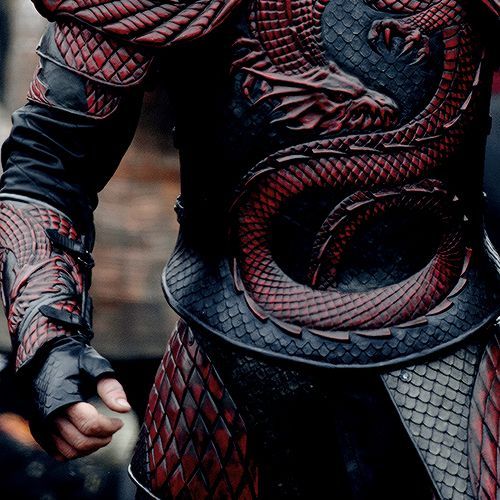
Costume from Dracula Untold.
Games:
Stemming from their religion, aeon coin games are popular throughout Kamikita. The richer people will use magical seals in place of playing coins, and collecting seals/coins from different people and places is a place of pride for the more adamant players. Soldiers enjoy GK's knight tourneys, specifically their dragon taming and elemental fights.
Clothes:
Humans use silks and cotton a lot more than other materials in their clothes, any furs are saved for large seasonal cloaks, and leather is used in light armour more than average clothing. Kamikita and GK have a lot of style similarities, bright colours and fun patterns, the important distinction is that floral patterns are reserved for royals in Kamikita. But with Birkina and Solistal, humans are easy to find in the crowd. The common patterns in lower class humans are dragons and suns. Formalwear is a kimono and far more plain, still light and colourful, but one solid colour with a solid obi belt. High class often make up for this by bringing delicate sun umbrellas.
Food:
The major foods in Kamikita are wheat products, fruits, and their cattle meat. Because they have such a stable and mass produced agriculture, their hunting, trapping and fishing areas are less practiced, many in the profession coming from other areas in Klenith.
Animals/Plants:
Because this is fantasy Japan, the usual flora/fauna are going to mimic real life. so here I will talk about the fantasy creatures and how they interact with stuff and things :) Due to the coastal conditions here, there are no harpies, hydra or sea serpents, and the travel between Kamikita and Birkina keep the waters a well-traveled and safe area. There are mermaids but many keep their distance and the few that do approach the surface are looking to trade for the fruits of Kamikita's shores. Kamikita is also the only nation to house unicorns, and while pegasus do visit no wild ones are here. The fae and dryads have a huge population in the forests here, whatever their preferences may be, they seem to find it in this nation. Despite the natural flourishing here, treants are scarce. Perhaps they fear the more obvious sightings of dragons here. Outside of the fantastical, cats are hugely popular in the cities. They are lap warmers and aren't owned by any one person, but cared for by their cities as a whole. Dogs are common as workers alongside horses and are cared for the same way on farmsteads.

Ahmet Kurt on Unsplash.
Other Parts:
For Great Kettering. 1 / 2 / 3 / 4
For Solistal. 1 / 2 / 3 / 4
For Kamikita. 1 / 2 / 3 / 4
For Birkina. 1 / 2 / 3 / 4
#ted talks#my writing#the klenith saga#tws#my worldbuilding#worldbuilding#games#clothes#food#flora#fauna#kamikita#maashi#patience and glory#fantasy#high fantasy#humans#links#unsplash#undescribed image#settings#part 2#part 2 of 4#wtwcommunity
7 notes
·
View notes
Note
happy WBW! Are there sea monsters or unique sea creatures in Illaros?
Oh 100%, there's so many spooky fish in Illaros. This is going to be a long one. To start with, Illaros is mostly ocean. The continent of Iarl is about as big as Europe flipped vertically and the Janazi archipelago takes up about the same perimeter. The ocean that covers the rest of the globe is called the Oresea. No sailors have ever returned from trying to cross it, and even sirens don't venture too far into its tumultuous reaches.
That said, there's a lot of sea creatures. For this, I'll focus on the physiology of seafolk and sea monsters, rather than their histories or culture. There are three main types of seafolk; sirens, halawemavira (selkies), and merrow. The two coolest sea monsters are leviathans and drakelings.
Let's start with sirens. Appearance-wise, sirens have the upper half of a beautiful, pale skinned, dark eyed human and the lower half of something like a rainbow colored lionfish with long pectoral fins, called wingfins, used for riding the currents. Sirens appear the most humanlike out of all the seafolk because they evolved as predatory mimics. The earliest siren ancestors lured humans in with their looks and music in order to kill and eat them. Now, this practice has evolved into sacrificial rituals, but we're getting off topic.
The siren habitat is the deepest part of the ocean. They've evolved incredibly light-sensitive eyes (that black iris is mostly pupil) and have keen hearing they rely on even more than sight. Many sirens are also bioluminescent, though not all. All sirens, however, have access to the Voice. Whose voice you might ask? Why, the Voice of their god. Using the divine language, they can charm people and summon storms, with many other effects being available with training. Sirens can use the Voice also to take on a humanlike form. On average, a land-bound siren is a foot taller than a human, with pale skin and black, light-sensitive eyes.
Now, onto halawemavira! There are two types of selkie; halawemavar (scale selkies) and halawemavish (seal selkies). Halawemavira is the general term for both groups as a whole. The two races consider each other to be sister cultures, and they speak similar languages, as well as worshipping similar spirits.
Halawemavar live exclusively in the N'Diki swamp of western Iarl. They have flat, scaled faces, jagged teeth, and barbles over their eyes and in place of hair. Their tend to be small and lithe, with hydrodynamic tails meant for maneuvering around a mangrove swamp rather than riding the ocean currents. On land, they are much less human-looking than sirens. They retain their sharp teeth, their hair is the color of their scales, and they keep a scaled cloak with them at all times as their connection back to the water. The evolutionary reason (evolution gets weird with meddling gods) they have land forms is because moving enclaves every time the dry season comes sucks. Halawemavar live underwater during the wet season, subsisting off fish and seaweed farms, and on land during the dry season, eating game and foraged plants.
Halawemavish are similar to halawemavar, but with a seal-like bent. Their ocean form has a human upper body, though with dark eyes, a coating of fur, and pointed ears, and the lower body of something close to a leopard seal. They also have very sharp teeth. On land, their skin is gray, their eyes are solid black, and they wear a sealskin cloak. During the winter months, halawemavish live on iceberg villages. When the ice melts in the summer, they migrate to their villages on the sea floor. Halawemavish live across a much broader range than halawemavar, with villages all over the northern coast of Iarl.
Merrow are the seafolk I've developed the least. I picture them like dnd sahuagin, but with tails and red, orange, and pink scales. They have no land form, so they largely ignore the surface. Their government does, however, run the Trench, a prison used by all of Illaros to hold the things they can't kill, and prisoners who deserve worse than death.
Now for the monsters. Instead of dragons, Illaros has leviathans---massive, many-finned serpents of monstrous power. They are like animals when they're young, feeding indiscriminately and moving on instinct. As they age, a cunning intelligence develops, as does power over the wind and water. Some leviathans keep to themselves, content to explore the mysteries of the world. Others become something like vengeful demigods, conquering vast swaths of ocean territory. It's because of this that most people will kill baby leviathans on sight, so as not to risk being subjugated under an all-powerful serpent years later. The only things that help keep leviathans as the distant, mythic threat they are is that they grow very slowly, they're incredibly territorial against one another, and they reproduce infrequently. Still, there have been a few eras in Illarian history where the seas have been ruled by a leviathan empress.
The other more common, if less existentially terrifying, sea monster is the drakeling. A drakeling is something like a giant, six legged, frog/dog that spits acid. It's much less cute than whatever you're imagining. They dissolve boats so they can eat the sailors within, and while they're not very smart, they definitely have the capacity to hold grudges. Female drakelings are much bigger than the males. It's common for halawemavar to scavenge the corpses of females killed during the spring rut and sell the valuable acid to alchemists.
Well, this post is long enough, I think. Illaros has a lot of ocean stuff. Thanks for asking!
6 notes
·
View notes
Text
“Politicians and cultural leaders have made various assertions that homosexuality was never practiced in traditional sub-Saharan Africa during precolonial times. Such statements generally suggest that it was imported from outside sub-Saharan Africa with Arabs and colonialists often being blamed for it. […]
It has been documented that homosexuality is as indigenous to Africa as heterosexuality. Many practices that occurred across the continent could clearly be regarded as same-sex ones, [including] woman to woman marriages, which take place in more than 40 ethnic groups spread across sub-Saharan Africa from South Africa, through Benin and Nigeria, to Kenya and South Sudan. Others that were accepted in some African societies of the past include men treated as women, for example such individuals among the Langi in Uganda might even be allowed to marry men. Ancient paintings and traditional dances in language provide evidence of a history of a Mystic surety in the continent. […] Furthermore, many indigenous languages contain words that refer to homosexuality, for example, the Lugandan word bisiyaga. […] In the Shona language the words murumekadzi and mukadzirume can be loosely translated as man woman and woman man respectively. The first refers to a man who takes on female roles and the second to a woman who takes on male roles. […] However, these practices may not easily fit within today’s description of same-sex relations and tags like ‘LGBTI’. They had many different purposes, perhaps the least of which were sexual pleasure. For example, men who took on female roles would sometime do so because they were possessed by spirits –that is, they were acting as mediums for female spirits. It is important to note that the individuals involved in such practices usually conformed to the dominant heterosexual way of life. They went on to marry, have children and be part of heterosexual/heterocentric families. In this sense, such persons were similar to those of today described as ‘in the closet’.
It is also important to note that some of these practices were documented more by non-Africans than Africans, usually with highly disparaging language. The heterosexist worldview of these authors perhaps prevented them from setting the practices more thoroughly and thus discerning their real nuance, meaning and significance. For example, the Buganda king, the Kabaka, is commonly referred to as a Bbaffe, which loosely translates as ‘our husband’. Used by men and women in reference to the king, the term could easily be mistaken as meaning that the Kabaka was literally a husband to both men and women in the kingdom, and it was acceptable for him to have physical relations with both sexes.
Another vivid example can be found in the Portuguese descriptions regarding the Shona Kingdom of Mutapa and its king, or Mwene Mutapa. The Portuguese described the Mwene Mutapa’s advisers as ‘women’, which was due to literal translation of the term used for them. The implication was that, since they were regarded as women, the king treated them as his wives and could perhaps have sex with them.
These precolonial practices were not necessarily encouraged in these societies, but nor were they necessarily punished. Precolonial African societies tended to place an extremely high and prodigiously over determined value on heterosexual marriage and reproduction. Individual sexual desire was largely subsumed to the broad interests of the extended family or lineage. Despite this, individuals were often given leeway to veer from accepted gender roles and sexual practices, provided they do not affect the broader interest of society. As such, homosexuality –just like celibacy and adultery– was deliberately not encouraged but at the same time it was not suppressed. Such things were simply ignored and hardly discussed. This is perhaps the source of the strange consensus that there was no homosexuality in traditional Africa.
More importantly, these practices were not criminalised. All African societies had established social norms, and deviance was usually punished. For sexual deviance the punishments were particularly heavy, and so, if heterosexuality was one norm from which no deviation was allowed, punishments for homosexuality would have been prescribed. Thus, the fact that there seems to be no designated punishment for same-sex relations points towards tacit acceptance of these practices, rather than the assertion that they did not exist. Indeed, it could be said that it was colonialists who first introduced criminalisation of homosexuality.”
-Adrian Jjuuko and Monica Tabengwa, “Expanded criminalisation of consensual same-sex relations in Africa: contextualising recent developments”, in Envisioning Global LGBT Human Rights, (Neo)colonialism, Neoliberalism, Resistance and Hope (2018)
#queer history#queer stuff#precolonial history#i love this book sm#also lol at everyone blaming arabs and persians for homosexuality sorry for being the og i guess
8 notes
·
View notes
Text
[Wings of Fire] IceWing Headcanons
Getting closer to the end of the tribe headcanon series. When I'm done with the tribes, I'm going to do continent headcanons, history headcanons, and tribe evolution headcanons.
IceWings had animus magic at one point, lost it and all of their animus-touched objects, and then got the magic back many centuries later. Some suspect that the magic was lost intentionally following one of their animi going insane.
IceWings are the most artistic tribe and are popular for their paintings, carvings, architecture, and music.
IceWings have the weakest immune system due to their lack of exposure to disease in the arctic.
IceWings mate for life and ones who don't are often judged and seen as lesser than.
IceWings have heated greenhouses near the kingdom's capital where they grow fruits and vegetables. These were gifted to them by an ancient animus IceWing.
Animal furs are the Ice Kingdom's leading industry in the economy. They also export narwhal horns and caribou antlers.
IceWings have the most variety when it comes to horn shape. Horn shape is usually genetic and varies most with the regions of the Ice Kingdom.
It is standard in the IceWing tribe for all IceWing dragonets to be raised practicing an artistic or athletic talent. This can be an instrument, form of art, physical talent (formal dancing, swimming, hunting, etc), or singing.
The biggest threat to IceWings in the Ice Kingdom is the environment itself. IceWings have to be cautious about blizzards and avalanches.
The IceWing Royal Family is represented by blue diamonds.
Traditional IceWing music is played with violins, violas, cellos, basses, harps, flutes, clarinets, pianos, chimes, gongs, and horns. IceWing music is typically formal and slow, just the right tempo for waltz-like ballroom dancing. IceWings pride themselves on their compositions and orchestral arrangements.
IceWings can have a range of patterns including gradients, dapples, speckles, feathery markings, and rarely, crystal-like patterns such as opalescence.
Besides the basic white, light grey, and pale blue scales, IceWings can also have purple and pink tinted scales, turquoise-colored scales, yellow-orange scales like a sunset or emperor penguin, and brown-tan scales.
One of the Ice Kingdom's most notable locations other than its palaces is the Crystal Plaza. The Crystal Plaza is a huge marketplace located slightly northwest of the center of the Ice Kingdom where IceWings from all over the kingdom sell and buy products from vendor stands. The Crystal Plaza is similar to the Scorpion Den but does not have any organized crime groups. The Crystal Plaza also resembles the Great Diamond in the old Night Kingdom but the plaza itself is only a small part of the market place which expands down organized rows away from the rhombus-shaped center.
Religious IceWings believe in the great Ice Queen, an ancient IceWing queen who is told to have raised the IceWings to greatness. The story of the Ice Queen describes how she conquered the harsh conditions of the Ice Kingdom and established the Ice Kingdom by leading a war against the Ice Monsters that live there. The Ice Queen trapped the monsters beneath the frozen ground of the kingdom, keeping them from being able to hurt her tribe. The Ice Queen has a large statue carved of ice dedicated to her in the Crystal Plaza that was created by one of the IceWings' first animi so that dragons can pay their respects to her. It is believed that the Ice Queen's soul exists as the northern lights and that she protects all dragons who follow the Principles of Eminence, a list of rules that were carved in ice, supposedly by the Ice Queen herself but they appear to be too recent to have been her.
73 notes
·
View notes
Text


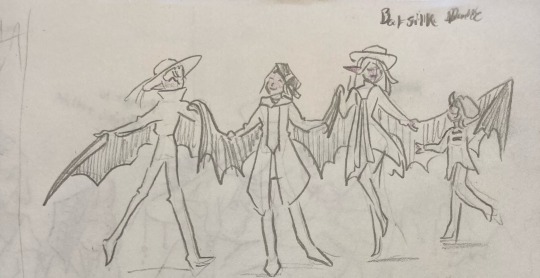
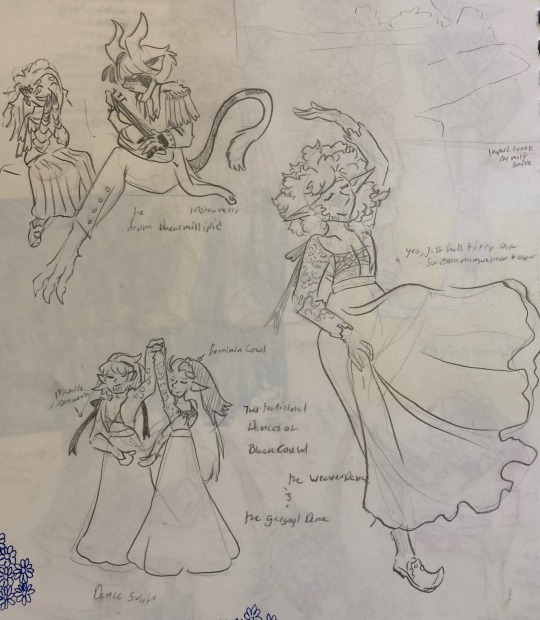
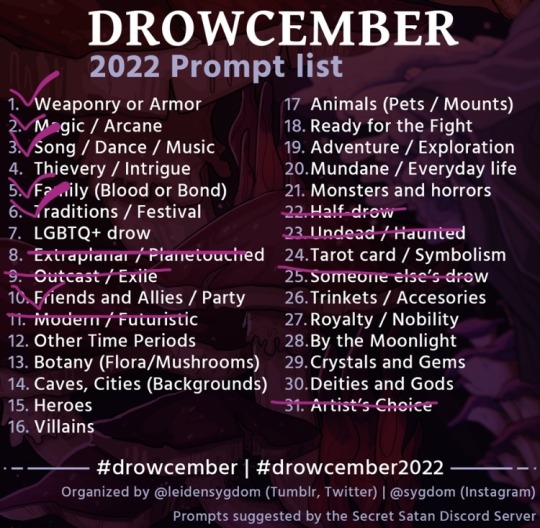
So I was browsing tumbler a few days ago and stumbled across something called drowcember. And I thought it was a fun idea so I found the years prompt list I decided to do a few of the prompts as a world building exercise on the society that is inspired by the dnd drow. The dark fauth.
That being said there is not a lot of things regarding the dark fauth yet so this is a WiP pice but I am enjoying how it is developing so far.
The dark fauth are a number of societies that hide out in the vast cavern systems of the south western port of O’sten. It is a place that has grown from being one of the few places that people with no where else to go can go, And over a long time and under the influence of the strange magic of the underworld the people have changed.
It is not only the Elv that live there but many other creatures, raquesasha who washed up from the distant continent of mergo and thier decents a long with the vicker who arrived here with a similar fate. Seen as sea devils by the society of O’sten and forced to live here.
In O’ller and O’sten they only recognize a few groups, the human societies, the fauth, the dark fauth, and jevels.
For this bout of prompt baised world building I decided to to focuse in on three city states from the underworld.
The grotto city of Elgar; the cavern bats.
The cavern city of Bal’kac’howl; the black kowl spider.
And the deep city of orgi’alli; the duel millipede
Prompt 1: weapons and armor: I’m not an ameture in drawing armor but I am also not that skilled in it. Picture one
So on the left we have a person from the cavern bat city, wearing a padded jacket and leather armor that sports a characteristic high collar of the city. Their short blades are called night catchers and are a modified dagger meant to wrap around shields and the Handel of exes and blades of swords to deflect blows easily. The front portion is shallow but sharp and roughly an inch (254 mm) in length. The curve is not as sharp but still meant to cut. They are also known for wielding spears.
In the middle we have a black khowl spider warrior, she is wearing glare resistant war paint. Along with the charred ivory hair comb, and the characteristic black shawl of the citizens of the city. The armor is covered in intricate decorations of spider webs. The weapon of choice is short brutal battle axes that let them manover in tight spaces
The armor on the right belongs to someone from the city of duel millipedes. They are wearing a chitinous armor of many overlapping layers that is covering the vitals while still allowing for flexibility. The weapon in their hand is a short kilv. A curved weapon that has one sharp outer edge and a curve with a sharp inside. These blades are well known to be particularly sharp and hard.
Prompt 2: magic/ arcana: so the most infamous part about the dark fauth for the surface dwellers of the world is that they practice dark magic. Which is simply the term used for magic not practiced by the accepted understanding of how magic on O’sten and O’ller works. Each city tends to have a magical specialty of thier own. Though this is not always the case. The magic specialties of these three cities are for cavern bats: they specialize in glyphs and magical arrays but also still practice the magics of the surface world as they live in a giant grotto. They also have a a fair amount of alchemy practiced as well.
Black Khowl: they allow themselves to practice wild magics. Especially any kind of magic that comes naturally to individuals.
Duel millipede: they are most well known for thier alchemy and rune work.
Prompt 3: song, dance, music: so here we have the bat silk dance of Elgar it’s a group dance and has several different dance forms for the bat silk. The one depicted is the rapt step.
In the picture below the rapt step bat silk dance is the dances of the black khowl.and the traditional costume of them as well with the high skirts and the silk sleeves (small open chest, long sleeves jackets that are highly embroidered and have complex ties in the front to mimic the intricate patterns of spider silk. There is the black shawl of wemon and the black ribbons of men. People will wear both or none as well. In the left hand corner of the drawing is a raquesasha playing an instrument that I have yet to name, with a bowl like body and an arm that is bent in a way to allow the strings to have a very low sound near the top and a bright, louder sound on the bowl. It is played either by plucking, strumming or by use of a bow.
And those are the first few prompts, I’ll see how many more I do.
#worldbuilding#fantasy#pandoramusicbox#fantasy magic#fantasy culture#drowcember#dnd drow#not doing a 30 day challenge the right way#oh well#sketch
14 notes
·
View notes
Text
Ba-Wahi
Many caverns and tunnels wrap around the ‘bones’ of Mata Nui, which act as support girders and foundational bedrock for the landscape. Some places in the Matoran Universe might have their gravitational fields centered around these bones; A cavern below Mata Nui’s femur will have gravity opposite that of a cavern above, like an upside-down world. The physics are kind of similar to what you’d encounter in Super Mario Galaxy; Some places in the Matoran Universe really have their gravity all over the place.
Again like Super Mario Galaxy, there will be caverns where gravity is situated along the surface, so that you can walk on the ceilings and walls. Some domes will flip their gravity past a certain height, with floating rocks often demarcating these gravitational borders (like the Hollow Earth in Godzilla VS Kong). Ba-Matoran have an innate sense regarding the direction of gravity and its intensity, and can safely navigate these areas, known as a Ba-Wahi, with little issue.
Those who aren’t Ba-Matoran will often find themselves disoriented by the unusual layout of gravity, disoriented by unexpected shifts; Some have incorrectly predicted whether the direction of gravity will shift or not, and in what direction, leading to quite a few accidents. Some Ba-Wahi caverns resemble space, with pitch-black walls and ceilings, studded with lightstones coming in a wide array of colors and arrangements like crystalline constellations.
A Ba-Metru is the same concept as a Ba-Wahi, but with buildings and rooms where the direction of gravity is openly marked, designed to be easily navigated; Some rooms have gravity oriented in one direction, others have multiple directions assigned to different areas and sections. Spherical chambers where inhabitants can freely walk along the surface also exist. Ba-Metrus are often very small and concise compared to other cities, as they’re able to make the most of interior spaces; And a few zones have gravity’s direction shifted around, according to the time of day and/or function, as part of the city’s routine. This is usually done to facilitate some manner of travel and/or render some areas more, or less, accessible at specific intervals.
And of course, some areas of the Matoran Universe lack gravitational fields altogether, especially in those crystalline caverns that resemble the constellations in space; Gravity is instead anchored at several points scattered throughout the interior, namely the centers of various structures floating about these caverns, often rooted in one point through stasis technology, others orbiting around even larger structures. Miniature planetoids are a common sight, as are floating islands, with bridges and ropes connecting them to each other for travel.
Jetpacks are a favored mode of transportation in a Ba-Wahi or Metru, but not as practical elsewhere. In areas where gravity is mixed and matched and skewed, natural flyers have also managed to adapt to the environments. Unique Rahi that float and drift through ‘space’ have been designed by the Makuta, able to effortlessly navigate the gravitational ‘currents’. Aquatic caverns are easier to navigate, but nevertheless disorienting in their own way, and are populated by all strange manner of life.
Since ‘up’ and ‘down’ are arbitrary terms amongst Ba-Matoran, many have maps of the Matoran Universe considered to be ‘upside down’ compared to how most people perceive it. This is a matter for debate; Especially as in space, there is no up and down, and this is where Mata Nui spends most of his time. The majority of the Matoran Universe’s gravitational direction is arbitrary, though the intent of the Great Beings’ design is worth considering.
Voya Nui’s break off from the Southern Continent probably had something to do with this system of conflicting gravitational pulls and directions; The Southern Continent likely boasts, or is located near, a massive Ba-Wahi of its own. Said Ba-Wahi’s inverted gravity must’ve interfered with Voya Nui’s during the Great Cataclysm, contributing towards its ejection as did the eruption of the Codrex’s energies below.
On Spherus Magna, natural gravitational fields skewed from the rest of the planet’s gravity also exist; It too has its own floating islands, miniature planetoids, vertical cliffs that people can walk upon, and even massive underground caverns similar to the Ba-Wahis of the Matoran Universe. When the Great Spirit Robot was dismantled, many Ba-Matoran and other species used to these mismatched fields migrated to these locations; They find large swathes of uniform gravity to be rather limiting and constricting, and thus Ba-Matoran and their neighbors often prefer to remain isolated to a Ba-Wahi.
Hence, Ba-Matoran sometimes come across as one of the rarer variants of Matoran, when in reality they simply stay confined to a spot; As mentioned before, they make the most use of interior space, and so despite having relatively similar numbers to other elements of Matoran, come across as the most obscure. Recreating a Ba-Metru is simple, since Ba-Matoran are already familiar with artificial gravity as a mechanism and how to replicate, alter, or even neutralize it, with Ba-Toa not needing any technology to do so; The Ba-Matoran and their neighbors are the future pioneers of space travel.
39 notes
·
View notes
Note
I was reading your "Fallout 4 companions meet Arcade Gannon" reacts when I had an idea. FO4 companions reaction to visiting the Mojave Wasteland with the Sole Survivor.
"She was Boston, I was Vegas
She was Crêpes Suzette, I was pie
She was lectures, I was movies, but I loved her."
- Frank Sinatra, 1981, "I Loved Her"
Cait: "I've never been much of a gambler, but where there's gambling, there's usually a good time to be had."
While Cait finds the casinos of the Strip a little too ritzy for her liking, she rather enjoys the smaller, satellite venues: The Atomic Wrangler in Freeside, the Vikki and Vance casino in Primm, even the saloons in Goodsprings and the Mojave Outpost (the latter of which being where she foolishly engages in a drinking contest with Cass and happily gets her ass kicked). Her greatest enjoyment, however, comes upon discovery of the Thorn in Westside, with its arranged bouts between wasteland critters and the opportunity to go a round yourself if you're feeling lucky. Instead of the trapped horror she felt when the Combat Zone was taken over by raiders and she was forced to fight, Cait revels in the glory she reaps when choosing to face off against a fire gecko, a night stalker or a cazador with her trusty baseball bat. By the time the visit is over, she and Red Lucy have grown close, and the Thorn's mistress is going around openly calling Cait "my hunter."
Codsworth: "Ah, Las Vegas! Why, I can recall when you considered a quick getaway to this paradise just before young master Shaun's arrival. It appears we aren't too late, after all."
Codsworth is somewhat comforted by the lack of overt nuclear devastation in New Vegas, but that feeling wears off as soon as the first set of thugs in Freeside tries to corner him and the sole survivor and take their caps. Once the would-be muggers are laid out on the ground, Codsworth abandons his rose-colored glasses and puts his quippy, dismayed personality back on. Still, he loves the Strip, particularly the Ultra-Luxe with its refined guests, decor and hygienic practices, but he quickly sours on their hoity-toity attitudes. Instead, Codsworth turns to the presence of the NCR as a sign that civilization is creeping back into the wasteland. He's also tickled pink by the Kings and the Chairmen, but not the mobster-esque Omertas: They remind him too much of the pre-war mob activity in good old Boston.
Curie: "Excusez-moi, but what is that structure there? The tallest one, with the blinking lights."
Curie is thrilled to be out in the desert, observing the local populace and documenting their survival techniques, social structures and power struggles. She's fascinated with the area's history, and drags the sole survivor along to seek out the Mojave's most (in)famous individuals to record their stories for her research into post-war civilization. This lands her in quite a few questionable situations, but her general attitude of perseverance and wide-eyed wonder about the world open a lot of doors for her. She makes a lot of friends at the Old Mormon Fort among the Followers of the Apocalypse, though most of them assume her frustration about her own "biological reactions to extreme living conditions" is just her complaining about the heat like everyone else. Arcade's pretty sure she's a robot, though he's too polite to ask about it outright.
Danse: "We're close now, to the birthplace of the Brotherhood of Steel. This is an honor I never thought I'd experience."
Though it's boiling hot inside his power armor under the desert sun, Paladin Danse is overjoyed that he's accompanying the sole survivor on this journey into the cradle of the ideology that he's devoted to. He's heard about the Mojave from Brotherhood of Steel veterans, those who traveled with Elder Lyons when they initially came to the Capital Wasteland and those who accompanied Elder Maxson when he was just a Squire, and he keeps spouting off random trivia about the area. Any run-ins with disillusioned Scribe Veronica might leave him a bit put out, but it's overall a fun trip for him through a part of the continent that's a little less smashed to rubble than the rest of the world. He especially enjoys visiting the NCR and Brotherhood military outposts, if only to offer critiques and suggestions to any soldiers that give him the time of day.
Deacon: "Sheesh, visiting the Mojave almost makes you wish for a nuclear winter, am I right?"
Deacon has been here before. Well, he doesn't actually say he's been here before, but he keeps dropping hints to the sole survivor that he's somehow on a return trip. He knows the legends of the Sierra Madre and the Blue Star treasures offhand, he has a whole conversation with the Securitrons guarding the Strip about what happened to Robert House, he even knows how to competently play Caravan. Every time the sole survivor asks him about how he knows so much, though, Deacon just grins and keeps chugging his Sunset Sarsaparilla. Obviously no one recognizes him by face, but he does have a setting-appropriate wardrobe along that includes NCR bandoleer armor, a coat-tailed tuxedo, top hat and White Glove Society mask, and a black leather jacket to go with his pompadour wig.
Dogmeat: [curiously sniffs everything]
Dogmeat can't figure out why this place is so dang dry, but he's on his best behavior for the sole survivor as they make their way over the dusty roads of the Mojave. He politely greets each other traveler on the roads, who keep asking his companion where they got "a non-cyber cyberdog." For the most part though, the trip is pretty in line with everywhere Dogmeat goes: Big rodents, big bugs, tired people and plenty of ruins to explore. Dogmeat's one outstanding adventure comes in the form of an attempted kidnapping by some of the Kings, who think their leader needs a new dog after Rex hit the road with some fool. The King doesn't take kindly to this, and graciously has the dog returned to his friend.
Hancock: "Oh, man, how does anyone live out here? I'm drying out, I feel like a radroach husk."
Hancock is having the time of his life in the Mojave, apart from constantly complaining about how he prefers the Commonwealth's weather. He's chummy with everyone, but especially with the ghouls he encounters. He buys Raul a bunch of drinks and asks him about his past, he suggests future career paths and hobbies for Calamity, and he is absolutely enchanted with Beatrix the dominatrix. He's also rowdy enough to attract the ire of nearly every casino in New Vegas: The White Glove Society seethes when the sole survivor points out that his Revolutionary War outfit technically meets the dress code, the Omertas howl when he starts encouraging the strippers and sex workers to band together and take over the casino, and the Vault 21 dwellers keep asking if he's liable to turn feral. The Chairmen, however, treat him as something of a novelty and gift him with a seersucker suit to go with his jaunty personality.
MacCready: "You know, I played cards with a guy from out here once. He tried to teach me a game called... what was it, Candyman? Kilogram?"
MacCready has the barest smattering of knowledge about the Mojave Wasteland, and he keeps injecting it into conversations no matter how inaccurate it is. He's fascinated with the sole survivor's recollections of what Vegas was like before the Great War, and his expectations are sky-high by the time they arrive on the city's outskirts. Those expectations are absolutely met once inside the Strip, even if the sole survivor's are let down. MacCready is just tickled by the existence of a city that is solely dedicated to parting you from your caps, and he settles into each new business for the express purpose of people-watching. He only tries gambling once, and immediately quits after he loses all of his pocket change.
Valentine: "Good old Las Vegas. Somehow, I'm not surprised it's still got a reputation as 'Sin City,' even this long after the bombs."
The Nick Valentine of old never visited Las Vegas, but he certainly knew about it well enough for the Nick Valentine of today to draw on those impressions. He's extra-wary about the city as a result, an attitude not helped by the many people staring at him because of his detective getup, jagged edges and golden eyes. Some people are polite enough to walk up and ask what he is: Others offer to buy him off the sole survivor directly, much to Nick's chagrin. When James Garret offers him a thousand caps for "one night of his services," Nick puts his foot down and starts glaring at everyone who so much as walks up to him and the sole survivor during their trip. The exceptions to this rule are Veronica, who is extremely polite and non-invasive with her questioning; Arcade, who is too polite to even mention Nick's synthetic state; and Raul, who finds the whole thing hilarious but admits that his ghoul status has landed him in some similar situations.
Piper: "I've heard plenty of stories about this place, and if even a quarter of them are true, I ought to get a good travel piece out of just about anyone we pass on the street."
Piper's on a mission to track down the history of New Vegas, which, like Curie, sends her on a path toward its biggest political figures. Aside from them, she's particularly interested in the services of the Mojave, like the Gun Runners, the Crimson Caravan Company, and especially the Mojave Express. Piper gets along swell with just about everyone, and she basks in the widespread acceptance that she lacks back home due to her chosen profession. She desperately tries to get Johnson Nash to ship a case of Sunset Sarsaparilla cross-continent for her, but he gently turns her down and tells her that the only courier he knows crazy enough to undertake a trip to the Commonwealth is too busy nowadays.
Preston: "They're not too friendly to outsiders here, or so I'm told, but there are always good folks to be found if you know where to look."
Preston, true to form, offers help to every little settlement he and the sole survivor come through on their journey, which delays their path to Vegas quite a bit. He makes a beeline for the Old Mormon Fort as soon as he hears the Followers of the Apocalypse have a base there, though, and spends most of his visit picking the brain of its leaders about the best ways to aid those in need in the wasteland. He and Arcade get into some spirited debates about the pros and cons of having a civil service force focused on military matters versus civilian matters, and the Minutemen leader leaves the Mojave with a lot of new ideas to carry home to the Commonwealth.
Strong: "Strong not looking for 'good time,' puny human. Strong looking for thing that make super mutants stronger."
Strong hates New Vegas, but that's nothing unexpected. The sole survivor tries to limit their time in the city and take him around the desert to locales where super mutants are more likely to be found, which brings them to Jacobstown. Surprise surprise, Strong hates Jacobstown - at first. Little by little, through talking with Lily, the other nightkin, and Marcus, Strong starts to realize that the super mutants of the town are doing exactly what he values and sharing their resources among each other for the good of the community, just minus the usual violence associated with super mutants. He struggles with this alternative way of life for a bit, but eventually comes to accept that to be a super mutant, you don't have to constantly attack those around you to show off your strength.
X6-88: "Be careful. The Institute's records about this area indicate high levels of theft, murder, and unsavory characters. It would be best to keep our guard up."
Like Nick, X6-88 greets everyone in the Mojave with open suspicion, and can hardly be convinced to leave the sole survivor's side for their entire journey. His dedication to this task leads those around him to joke about him being "a human Securitron," which the sole survivor finds amusing: X6-88 does not. Still, the ability to hire and maintain a professional-looking bodyguard while visiting New Vegas doesn't go unnoticed, and most people assume that means the sole survivor has a lot of money to spend or be separated from by force. Criminals are more likely to be ruthless, hell-bent on stealing the loads of caps the sole survivor surely has tucked away. Business owners, on the other hand, are more polite to the pair on their travels, giving them better service and goods that ingratiate X6-88 a bit more to the common people aboveground.
BONUS!
Ada: "Jackson brought us out here once, when Zoe decided she wanted to try acquiring a Securitron. The leader of the Strip turned us down."
While Deacon is playing coy about his experience in the Mojave, Ada is completely open about hers. She hasn't been to the Strip, the dam, or any of the Mojave's "fun" destinations, but she remembers the Crimson Caravan Company headquarters, the 188 trading post, and many of the small towns along the way. Her fondest memories are of scavenging around the ruins of the REPCONN test site, the Aerotech Office Park and HELIOS One. She also recalls that her caravan friends came to visit primarily to find a Securitron to take apart and repurpose, but won't say exactly what happened when they tried to do so, other than warn the sole survivor "not to invite the wrath of the House."
Gage: "Now this is a town that knows how to run a successful racket. We need to find out who's in charge, see if they can give us some tips."
Porter Gage walks right up the steps of the Lucky 38 as soon as he finds out that someone inside is running the Strip, and demands that the Securitrons let him in to "talk to the boss." The robots aren't impressed, of course, and toss him out straightaway. Gage, not one to be discouraged easily, tries to find information among the nearby raider gangs instead: Fiends, Vipers, Jackals or Great Khans, he's not too picky. The current state of the raiders in the Mojave quickly informs him that they're failing one by one against the power of New Vegas, and he renews his efforts to find the recipient of the endless streams of caps. Thwarted at every turn, he and the sole survivor retire to Gomorrah, where they bemoan their bad luck while the courier sits a few seats down from them, listening in and smirking.
Longfellow: "Just point me to the nearest saloon. If I can't cool down, I'll try to forget I'm hot."
Longfellow parks himself at the nearest watering hole and does his best to avoid the scorching Mojave heat. The Maine-born grandpa is pretty miserable during the daytime hours unless he's sitting in front of a fan with a cold beer, swapping stories about Far Harbor critters with the bar regulars. At night he's a bit more open to adventuring with the sole survivor, when the desert cools down and he can see the sights by moonlight. Although he's not a fan of the hustle and bustle of the Strip, most of the large casinos there have air conditioning thanks to the Lucky 38, so he claims a table in the back and glares at anyone who disturbs him and his drink. He gets along with most of the New Vegas crowd though, if they agree to pick up the tab.
Maxson: "We came this way, when the Elders sent me to the East Coast. I wonder if the chapter here is still persevering."
Elder Maxson is surprisingly reluctant to visit the two things that the sole survivor would've thought he'd be interested to see in the Mojave: The Strip, or the Hidden Valley bunker. If pressed, he'll admit that he's not the type to cut loose and gamble, drink or participate in general debauchery as a result of his upbringing and position of authority, but neither is he keen to drop in on the dying Western chapters of his order and become stifled by protocol and ass-kissing. He prefers to wander the desert itself, seeking solitude among the cacti and under the stars. Given the chance, he'd probably nip off to Quarry Junction and anonymously solve the NCR's deathclaw problem, if it hasn't already been taken care of. He refuses to wear his uniform for the entire trip.
Desdemona: "The Mojave probably wouldn't know what to make of our mission, which is how you know it's a good place to hide. I wonder if any of our rescued synths made it out this far."
This is by far the most relaxed the sole survivor has ever seen Desdemona, and why wouldn't it be? She's so far removed from her usual sphere that she drops her usual, tight-knit demeanor and embraces loosening up. She's still not talking openly about the Railroad's operations, but she is more likely to answer questions both personal and professional. Like Deacon, she knows a bit about the Mojave, but not so much that she can blend in completely. Instead, she embraces being a tourist and does all the usual things that go with it: Visiting the Strip, the Sunset Sarsaparilla headquarters, the Thorn, and especially Hoover Dam. When she's looking out over Lake Mead, with the sun getting caught in her hair as it sets on her left, she almost looks happy.
#all aboard the mojave express#wait that expression doesn't work#unless the sole survivor and company are mailing themselves to the desert#fallout#fallout new vegas#fnv#fallout 4#fo4#desdemona#maxson#elder maxson#elder arthur maxson#arthur maxson#old longfellow#porter gage#ada#mojave wasteland#x6-88#strong#preston garvey#piper wright#nick valentine#robert joseph maccready#maccready#hancock#mayor hancock#john hancock#dogmeat#deacon#danse
118 notes
·
View notes
Text
Adventure, 02, pragmatism, and humanism (morality of fighting, conflict resolution, the importance of personal choice, etc.)

Adventure and 02 are naturally very idealistic series, but despite being idealistic, there are times when they can get rather pragmatic -- even uncomfortably pragmatic in ways that seem a bit unusual for a kids’ show. The entire last quarter of Adventure and almost all of 02 dealt so heavily with the topic of “is it okay to fight, even if it means incurring deaths?" to the point it’s pretty hard to miss, but both series have an approach towards the morality of fighting, the possibility of potentially having to kill enemies (including former friends that have turned antagonistic), the approach to dispute resolution, and the meanings of “moving forward positively” and “not getting hung up on needless negativity” that are surprisingly nuanced. At times, there’s even a strong message that warns against getting hung up on preachy principles that sound noble on their face but actually don’t get anywhere in practice.
This is a handful of topics, and it’s to the point where it may seem a bit strange to condense all of these under one meta instead of dedicating separate posts to it, but I decided to on the grounds of the fact that they’re all very tied to each other in the course of Adventure’s narrative. Overall, both series are very kind to the feelings and mentalities and thoughts of the young children involved, having the characters not only be kind towards each other but also encouraging the audience to understand their feelings. This is an approach towards understanding oneself and others that happens to be very applicable to life in general, even for adults; both series float a balance of being pragmatic and yet humanistic, kind to the struggles and internal thoughts of all of the characters within, and have a surprisingly nuanced look at what it means to take part in conflict and what the “best thing to do” in such a case is.
As said above, this is a long and complicated meta, and it’s to the point where I’ve considered separating it into multiple parts or posts, but in the end could never bring myself to because of how interrelated all of these topics keep ending up with each other. So, to spare those of you who are intimidated by the sheer length and winding-topic nature of this, here are the main points:
One who is not emotionally ready to fight, or is unwilling to fight, should not be forced to fight. On top of it being inhumane, emotional exhaustion is treated much in a way similar to physical exhaustion; especially in a world where fighting strength is linked to emotional will, one whose heart is not in it will not even be able to effectively fight in the first place. Even when joining the fight is the obvious ideal solution, one who needs to sit out should not be blamed or scorned for it. A choice to fight is exactly that, a choice, not an obligation; the world is messy and imperfect, and the most you can do is try to do whatever you can within the best of your ability. If you do, there is no reason you should be scorned for it.
There are many meaningful ways to contribute to the overall fight that don’t necessarily involve direct physical violence; those ways are still valuable and necessary, and those more attuned to those roles should embrace those roles if it makes them more comfortable to do it that way.
If an extreme result -- such as killing the enemy -- is reached, it needs to be done with the first and foremost priority being to protect people and prevent casualties. A diligent effort should still be made to preserve as many lives as possible (which means this isn’t something where you get to go all “knight templar” and beeline for a violent solution) -- but sometimes, there will be times when push comes to shove and that most extreme solution will have to be reached, even if that “enemy” was originally a friend, because inaction will very obviously lead to more people being hurt.
When a dispute about important points like the above is reached, everyone’s feelings must be acknowledged. This is not to be confused with philandering around with a “both sides have a point!” compromise; in fact, Adventure and 02 both make very firm stances on the above issues. Rather, it makes it clear that said points need to be made while not invalidating the other person for having those feelings -- that is to say, there’s a huge difference between “your opinion is wrong” and “you are stupid and unreasonable for having that wrong opinion.” Dispute resolution and understandings can only be reached when you properly understand why the other person came to that conclusion, and treat them with proper empathy and compassion while you try to work it out. You don’t have to acknowledge their point, but you have to acknowledge their feelings. (For those of you who have seen Appmon: Shinkai Haru is a master at this technique, and there are multiple times during the series where he will very assertively make his case against others while still appealing to the other person’s feelings and never denying their right to have them. This is also an extremely useful technique for dispute resolution in general, and I recommend that those reading this consider employing it more often, at least assuming you’re dealing with someone who’s open to listening.) Likewise, to truly reach out to someone and support them also requires understanding their feelings -- you can’t truly “support” them unless you’re capable of doing so.
There is a certain limitation in which adhering too closely to “moral principles” ends up becoming impractical, and don’t end up contributing to anything in the long run -- fixating over things like grudges, revenge, “punishing” people, and even the concept of forgiveness can quickly turn into platitudes. The best way to move forward is to not fixate on those principles or get hung up on the past, and rather think “now that we’re at this point at the current moment, what’s the best way to move forward in a way that helps others the most and minimizes harm?”
Adventure and the morality of fighting, and the necessity of personal choice
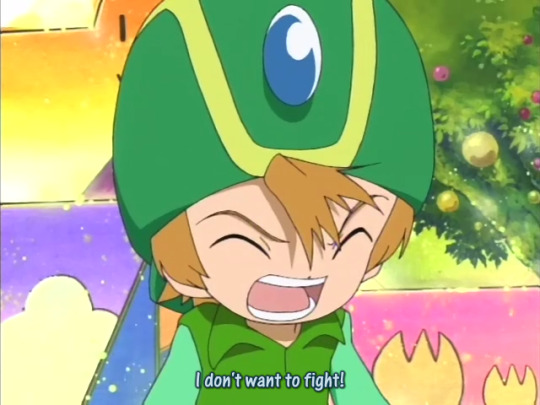
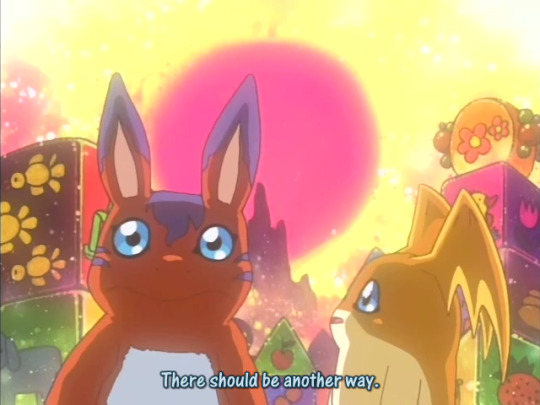

Believe it or not, the question of how feasible pacifiism is was first brought up as early as Adventure episode 12, when Takeru states that he has no intention of fighting Devimon. Elecmon calls this mindset out for the naivete of thinking they can just waltz up to Devimon and ask for answers instead of him trying to murder them on the spot -- and, in fact, he is completely right, because Devimon is not someone who can be reasoned with and indeed immediately tries to murder everyone on the spot one episode later, which results in Angemon’s death and Takeru trading out this very idealistic, naive mindset for the no-compromise, strict anti-darkness stance he takes in 02.
So there are two things to get out of this. The first is that, while Adventure and 02 are certainly very idealistic series, they are absolutely not naive. There are bad actors out there like Devimon who can’t be reasoned with whatsoever. Already off the bat, we have a clear statement from Adventure that an “everyone should stop fighting and get along!” mindset, when applied ad absurdum, is not going to get anyone very far.
The second is that none of the Adventure (or 02) kids like fighting. Takeru’s reaction here is certainly as extreme as it is because the idea of “fighting” presumably triggers his trauma from his parents’ divorce and the resulting split, but there’s no actual indication that any of these kids are necessarily fond of it. Certain ones like Taichi might get a little cocky midway through the battle when they’ve gotten it in the bag and are on an adrenaline high, but there’s also no indication that they’re interested in beating stuff up for the sake of it. Note that all of the fighting in Adventure episodes 1-10 was done out of sheer self-defense, and no Digimon was killed in any of the resulting battles (we’ll assume that the giant Bakemon in episode 11 doesn’t count mainly because it’s already dead) -- it was always fighting to the minimal amount to chase the attacking Digimon away or get them off their back. And, in File Island, that was possible -- but starting from the Server Continent and after, the hostile Digimon were actively out to kill them instead of just being territorial wild Digimon, forcing the Chosen Children to up the ante in order to survive.


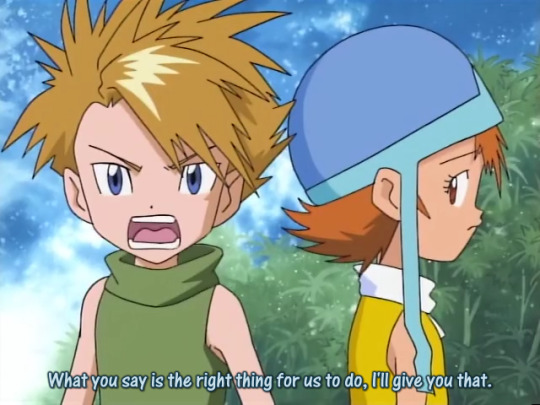

The issue of “whether fighting in itself is the right thing to do” is brought back in the Dark Masters arc, and this is also where we start getting a discussion about the disparity between “the right thing to do” and “whether one is capable of doing said right thing to do”. Mimi, the most emotionally sensitive of the group, starts having an emotional breakdown over whether they should keep fighting and potentially drag in more casualties -- especially because the Digimon that had died had all done it for their sake in order to continue the fight, and therefore the Chosen Children are indirectly responsible for their deaths. Yamato thus explains the difficulty of the situation: he himself agrees that Taichi’s evaluation of the need to push forward and continue the fight is the right thing to do, but it’s inhumane to not consider the stress and and emotional toll this is causing and force everyone to continue in spite of that.
In addition, Taichi’s reasoning for why they should continue is “revenge” -- a very negative, spiteful reason very tied to “fighting for the sake of it”. It’s understandable for Taichi to have these feelings, but he’s going at it from the wrong direction, and he’s overall being very insensitive in this scene. Later, in Adventure episode 45, he says that he’s doing it for the sake of honoring the Digimon who died for them. In other words, a lot of the reason Taichi’s methodology isn’t working is that he’s hung up on “the principle of things”, and not the more pragmatic reasons one should fight.
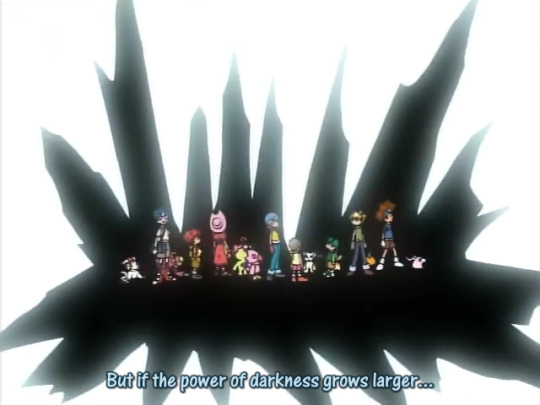
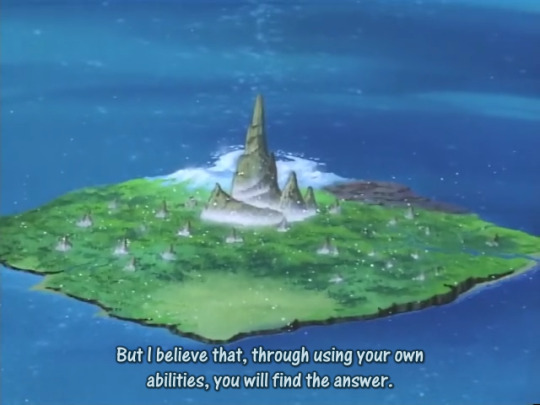
In Adventure episode 45, the kids finally meet the entity who chose them in the first place, who self-identifies as “the one who wishes for stability” -- the novels name them “Homeostasis”. Note the name -- it refers to the maintenance of internal balance within a living system, and Homeostasis themself starts their long infodump with their motive: it’s not that they want to eliminate all darkness from the world entirely, but that the powers of evil are upsetting the balance so badly that everything will be consumed if something isn’t done. It’s not like they’re insistent on violence either -- it’s just that they have a world to protect. The novels give us a particular amount of extra information on this entity, namely that it is not an omnipotent god by any shake of the imagination (in fact, there’s even an implication that there are higher powers that they themself don’t understand), and rather just a mere security system that observed that things were going south and used its rather limited methods of communication (via the Agents) to help make preparations.
Regardless, back to the episode -- we learn that the reason this entity recruited human children into all of this was because of the Hikarigaoka incident in 1995, which displayed to them and the Agents that a bond between children and Digimon could allow Digimon to evolve spontaneously, something that’s not possible with Digimon in the Digital World alone. Oh, and also, that they’ve been wanting to talk to them since File Island, and this entire thing about being cryptic with information was because they literally had no body and there was a massive amount of information loss after the Dark Masters blew up the Agents’ base and killed everyone except Gennai. In other words, just like with all of the actions the Chosen Children had been taking up until this point, everything Homeostasis and the Agents did was out of desperation because they were running out of other options to save their world, and during their brief time of being able to speak with the children, Homeostasis dumps pretty much everything they need to know and speaks to them using the extremely deferential sonkeigo form, meaning that they consider everything the kids are doing to be a massive favor to them. (Contrary to common belief, their possession of Hikari’s body does not seem to be non-consensual, given that they spend multiple episodes trying to contact her, and are clearly depicted having a proper conversation with her before temporarily borrowing her body.)
Most importantly, at the end of their speech, Taichi asks them what to do next, and the response is effectively: “We don’t know, but we trust you to make the best decision.” So, again: fighting as a Chosen Child is not an obligation, but something done because they want to do it and can. They were handed the tools to get this done by Homeostasis and the Agents, who believed in their potential to create miracles and be virtuous people and do something to save their world beyond what the native Digimon could do alone out of desperation and a lack of other options, and they are not hovering over the Chosen Children to see if they’ve “succeeded” or “failed” (note that they seem to have no sense of grudge or disappointment over Taichi’s SkullGreymon stunt in Adventure episode 16, explaining it very neutrally as an example of a risk), but more “we believe you were the best people who were able to do it and we trust your ability to help us.” (This is especially because, while it’s made clear they’d been wanting to contact them for a while, their most direct intervention comes right after Yamato had questioned why they were chosen in the first place -- presumably, they felt that the kids deserved an answer.)

At the end of Adventure episode 45, Mimi, considering the fighting they’re doing to be responsible for all of the fallouts and the sacrifices, decides that she won’t participate anymore, and Jou decides to stay with her in order to convince her to come back (although the novel also reveals that he himself is having doubts, too). Very importantly: nobody begrudges Mimi for being emotionally overwhelmed and sitting out, and nobody even begrudges Jou for choosing to stay with her. This is smack in the middle of the Dark Masters arc when everyone needs all the support they can get -- but after everything that had just happened, it’s inhumane to force either of them forward in this condition.
Despite his doubts, however, Jou himself is already coming to understand the limits of “pacifism” at a time like this:
What he wanted to tell her was this: that he didn’t see any likelihood of co-existing with the Dark Masters, and that they had no other choice but to fight them. Even a neutral country like Switzerland had a military. They would be invaded by enemy countries without one. It would be nice and ideal if they used the nonviolent resistance approach as Ghandi did. But that didn’t mean it was okay to just be killed without lifting a finger… But not even he could find a good answer.
Again: Adventure and 02 are an idealistic series, but they are not naive. It would be nice if the fighting could all stop and everyone would be happy, but there are malicious bad actors who will take advantage of you sitting there and doing nothing.

And so, Leomon dies in Adventure episode 47, and Mimi and Jou learn the hard way: if they do nothing, people will still die. Mimi had witnessed all of the Digimon sacrificing themselves for the Chosen Children’s sake, and thus had followed the logic that their friends would stop dying for them if they stopped fighting, but now that they’ve stopped fighting, said malicious forces (in this case, MetalEtemon) went ahead and killed their friends anyway -- and they’ve gone and destroyed the Village of Beginnings to boot, preventing any of them from being reborn. So in other words, if the intent is to “prevent casualties”, as it turns out, inaction didn’t actually prevent casualties.

Nevertheless, Mimi does not like fighting. In fact, Jou doesn’t like fighting either. Both of them now understand that it’s the best thing to do in this situation, but is it really the best thing to do to force them into embracing violence because of this? Instead, Jou determines in Adventure episode 50 that the overall fight doesn’t necessarily mean that everyone has to jump in and get violent -- the likeable and friendly Mimi has started to cultivate a skill in getting other people to rally behind her, and Jou is starting to consider that he may have a future in treating the wounded and supporting people before they become casualties. Those are still valuable ways they can contribute without forcing them into doing things they can’t bring themselves to do -- and, indeed, Mimi’s rallied army ends up saving everyone’s rears in Adventure episode 52.


While Taichi is not there to personally witness this discussion, Adventure episode 50 has him make a slightly less reckless tactical plan, and he explains (directly citing what happened with Yamato, Mimi, and Jou as his rationale) that he’s learned that he needs to take into account the potential for there being collateral damage. Recall that, earlier, his motive for doing things had been on a sheer principle level, with a lot of negative emotions of spite and revenge. But now, he’s come to understand that the most important thing he needs to do is to “prevent sacrifices”, and that’s the reason they still need to fight. Hence, why Taichi makes a proper plan for doing it instead of just doing the first and most aggressive thing that comes to mind, since he’s a soccer captain and has the potential for being a bird’s eye tactician, after all -- this time, he just needs to channel it in a way that prioritizes the lives of people around them.
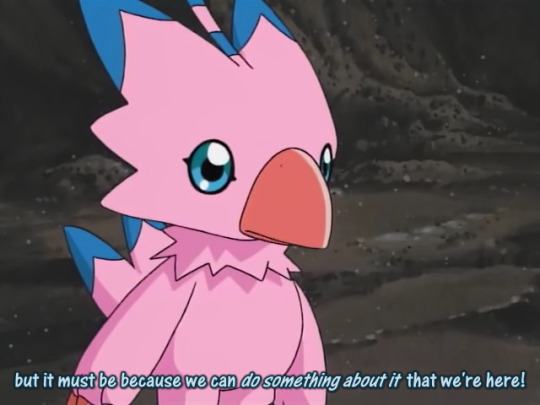
And in Adventure episode 51, when reaching out to Sora (who’s cracking under all of her self-imposed expectations and sense of duty to others), Yamato and Jou take what they learned from Homeostasis six episodes prior and apply it -- Sora is working under the mentality that they have an “obligation” to get this done and that they are impending “failures” if they don’t (and, to be fair, if they don’t make it, the world is going to end, which is pretty unambiguously terrible). But what Yamato and Jou do is reframe it to fall more closely under the philosophy of what Adventure is saying here -- the fact they can do something about it is already absolutely incredible. (I mean, not to sugarcoat the fact that the world is still going to end if they pull it off, but the stress, self-hatred, and self-blame of “we’re failures for not pulling it off” is definitely not going to help.) They are doing everything they can right now, within their reasonable abilities. If they end up not being able to do it, that’s not something that should be considered a sin or a failure on their part; they are here because they can and want to and are doing it and are here to make the best possible use of that.
It’s one of the many times Adventure and 02 will make this statement, indirectly or directly: despite the title of “Chosen Child”, the Chosen Children do everything they do because of their own choices, and because they want to, not because they have to.

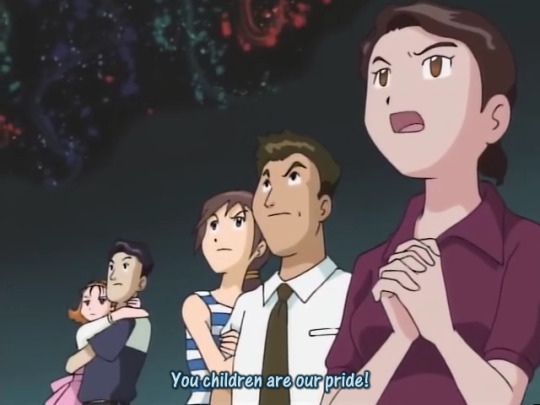
We finally meet Apocalymon in Adventure episode 53, and we learn that he(?)’s a combined spirit made up of all of the Digimon that were “eliminated” and failed during the evolution process, and is deciding to take out its anger and spite at the world out on everyone else by “denying evolution” (this is clarified in the novel to also be the reason it subtly influenced the prior enemies to destroy everything and especially the Village of Beginnings, because it functionally would put an end to the Digital World’s evolution by reducing it to nothing). So, in the end, we have a contrast between Apocalymon, who’s fighting for the sake of self-centered spite (including wanting to take down everything with it in Adventure episode 54 even when its demise is already clear), and the Chosen Children, who are fighting to protect their loved ones.

Incidentally, we also learn in Adventure episode 53 that there were Chosen Children who put an incomplete seal on Apocalymon prior to the ones in 1999. (Kizuna also introduces Menoa Bellucci, who became a Chosen Child in 1997, and assuming you’re following Adventure’s background doubling-every-year lore, at the time of 1999, there were a whole eight other Chosen Children besides Taichi’s group in existence.) The novels make it clear that the time dilation and distortion was going all the way up until the defeat of Apocalymon, long enough that the partners of those older Chosen were able to evolve to the Holy Beasts (and possibly enough for said older Chosen to get really faded through Digital World history to the point even Gennai doesn’t know about them). So the point here is that in the grand scope of the entirety of Digital World history, Taichi and his friends are not particularly singular existences -- there are people who saved the world before them, and 02 will introduce people all over the world who are going on their own adventures (including the main 02 kids in Tokyo), and, of course, by the time of the 02 epilogue, everyone’s going to have a Digimon partner. Koushirou later observes in Two-and-a-Half Break that there’s nothing special about having a partner in itself.
Does that make Taichi and his friends’ adventure of self-growth and saving a whole two worlds somehow insignificant, just because it’s not particularly unique? No. Because, again, they did this all not because of whether Homeostasis chose them or not, but because all of it was operated by their own will and strength and desire to protect others, all within the restraints of what they could feasibly do and handle, and they are amazing people for pulling that off.
02 and the importance of mutual understanding (and, also, more about the morality of fighting)

Before we proceed onto the 02 analysis, I think it’s important to establish a bit of important context about how 02′s lead protagonist, Daisuke, approaches things, and how it relates to the recurring debates on the morality of fighting throughout the series. In 02 episode 14, we learn that Daisuke was captured at Big Sight during the Odaiba Fog incident, and therefore witnessed, firsthand, the threat of Vamdemon’s lackeys attacking innocent civilians (something that Miyako, who witnessed the self-contained Omegamon vs. Diablomon battle on the Internet, and Iori, who only happened to be on a grounded plane after the Vamdemon fight had already ended, did not quite have anything on the par of). Spring 2003 and the Adventure novels elucidate what was going on in his head at the time: he was frustrated at his inability to protect his loved ones, and wished to have the power to fight the “bad guys” who were threatening everyone.
Remember this for later.
Moving onto 02 itself. 02 is a series about relationships, but, more significantly, it’s a series about the sheer amount of work it takes to maintain relationships, and especially the principle that “maintaining a relationship to another person requires being properly aware and understanding of the other person’s feelings.” One thing that often frustrates me about a lot of media (both kids’ shows and non-kids’ shows) and, well, to be honest, a lot of people in general, is the preaching of supposedly “positive” platitudes that actually go straight into what’s called “toxic positivity” for good reason -- because while it’s ostensibly “positive”, it also denies other people’s feelings, waving away everything negative and going “yeah, well, positivity!” and “optimism!” and “power of friendship!” and all sorts of stuff that are actually dismissive because they’re not showing any real effort to properly understand the other party and acknowledge why they feel this way. Like, sure, you may be telling someone to cheer up, but it also carries an (accidental or otherwise) implication of “you’re irrational and stupid for being upset and you should be smiling all of the time because ~positivity~.”
There is a lot of conflict in 02 -- especially because the theme of the morality of fighting is even more relevant, particularly in the case of the added question of “when the enemy in question is not an unambiguously evil sadist but a former friend in trouble”, and later the question of how someone who’s done horrible things in the past but is clearly making an active effort to make up for it should be treated. Daisuke, 02′s lead protagonist and carrier of a lot of its main themes, is ostensibly a simple-minded idealist, but even his theory of “positivity” and “always moving forward” has a lot of nuance beyond what you would usually see in this kind of anime lingo.



Context is also very important here. Adventure and 02′s stance being about “doing the best you reasonably can in a given situation”, it also means that what might be the best thing to do will change depending on context. 02′s starting circumstances are very different from Adventure’s, because it starts off without the threat necessarily being immediately world-threatening -- certainly, they need to stop the Kaiser, but this is in the form of a long-term territory war with an enemy who (at the time) doesn’t appear at night, and it’s unclear just how long it’ll take. This means that when the threat is not immediately world-ending, none of the kids are ever given grief for prioritizing their own personal obligations in lieu of fighting.
Iori and Jou do choose to ditch their kendo lesson and prep school exam (respectively), but they make it clear that they did this out of personal choice, and in fact this conversation opens with Armadimon apologizing to Iori for giving him grief for not coming, because he thinks Iori is perfectly within his rights to have stuck with the lesson! Perhaps, if the world were to end in a few hours, it would certainly be pretty idiotic to insist on sticking with a kendo lesson or prep school, because those things aren’t going to exist anymore if the world ends, but this is a very long and drawn-out territory war with no known end, and it’s understandable that these kids need to maintain their life necessities while straddling the balance between the war and their lives as a whole.
Again, they’re doing the best they can, and being a Chosen Child is about doing things because they want to, not because they have to.

This is especially because the Kaiser himself attempts to exploit the meaning of a Chosen Child in 02 episode 3 -- again, being a “Chosen Child” means being trusted to do the right thing with what you’re given, but the Kaiser basically betrayed that trust, and nobody was able to stop him from exploiting it and attempting a takeover with it. And Ken takes that title of “Chosen Child” and interprets it to mean he’s entitled to all of this -- but the other kids are Chosen Children just like him, and (at this point) all of them are simply choosing to do whatever they want with that.


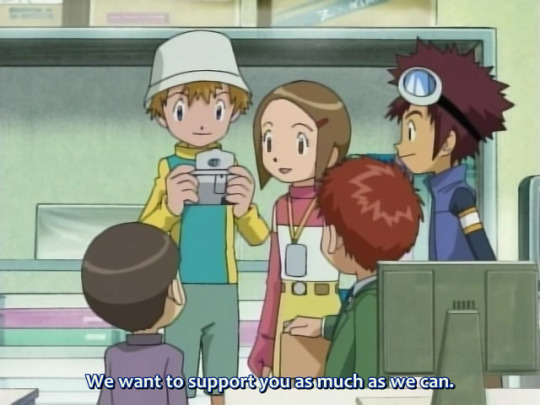
And on the flip side, you have the Adventure seniors, who are a little nerfed by the Dark Towers, but as far as the way the younger 02 kids see them goes, there is no doubt that the 02 kids respect them deeply and are practically reliant on their support and advice, and their experience and maturity in comparison to themselves. The episode that establishes most how in awe the 02 kids are of their seniors is 02 episode 17, where they learn the details of the adventure in 1999, and so it’s not about how much combat power they’re displaying right now but rather how much experience they have in doing such amazing things. Likewise, their seniors are frustrated at their inability to help -- not because they see it as some obligated duty, but because they see their juniors trying their best to deal with an ongoing crisis and want to help, resulting in them providing support roles such as covering for them with a camp trip in 02 episode 18 and allowing them to do a long-term Digital World stakeout. For this, the younger 02 kids adore them and give them all of their respect.
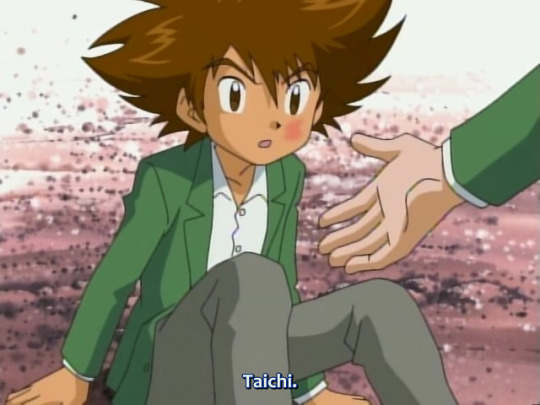

02 episodes 10-11 are significant in juxtaposing the themes of “conflict” and “understanding each other’s feelings” -- at the end of 02 episode 10, we see Yamato punch Taichi, but he holds his hand to him right after, indicating that Yamato punched him not out of anger or condescension or scorn over Taichi’s hesitation to fight Agumon, but rather simply to snap him out of it for his own sake, knowing he wouldn’t take it offensively, so in other words, what looked like a “conflict” on its face was actually communication between the two, with neither of them treating each other with scorn.
The conflict at the end of the episode is over whether they should run the risk of killing Agumon in the process of fighting him to get him back from the Kaiser’s Evil Spiral-induced brainwashing (note that this is about the risk, since it’s not necessarily guaranteed they’ll have to kill him, and they still of course need to make a conscientious effort to prevent that outcome). Yamato, however, frames it in terms of very practical matters, and even takes Agumon’s own feelings into it while he’s at it: if they pull back purely for the sake of not running that risk, Agumon will end up being the Kaiser’s slave and killing machine and nothing will be resolved, whereas if they run the risk, the best outcome is that Agumon is saved (which is, fortunately, what happens!), and the worst outcome is that he’s killed, which is still a preferable outcome to him having to remain the Kaiser’s brainwashed slave used to kill other things en masse.
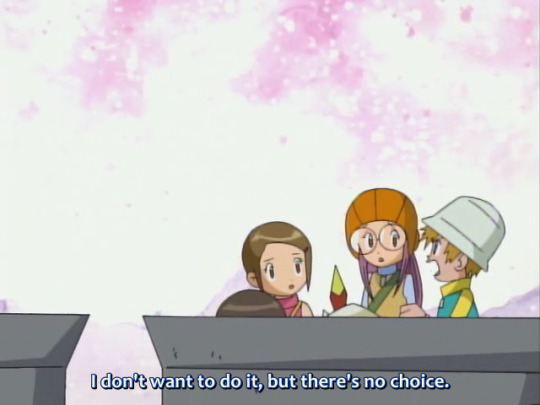
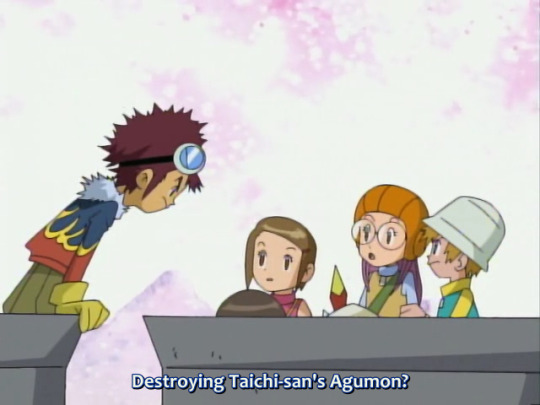

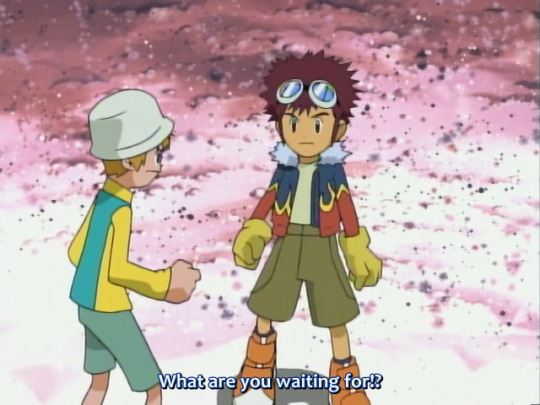
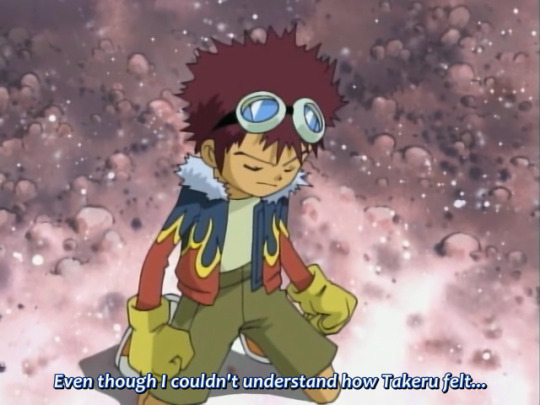
02 episode 11 further explores the theme of conflict in the face of “understanding each other’s feelings”, as it starts off with a fight between Daisuke and Takeru on the grounds of whether it’s okay to risk killing Agumon. Takeru’s stance is to side with Taichi’s decision, even if he doesn’t like it (again: just because some of these kids are able to make these decisions doesn’t mean they like it, and they’re doing it not because they’re callous but because they’ve thought hard about it and have decided it’s the best option they have!). Daisuke, being a bleeding heart, is appalled that Takeru could so easily endorse killing Taichi’s partner, and the two fight.
Note that the series does not “both-sides” this issue -- Taichi and Takeru’s stance is basically treated as the optimal course of action here -- but it also doesn’t invalidate Daisuke’s feelings of understandably being very shocked and appalled by this! Taichi and Yamato, in what initially seems like a violation of common sense, encourage them to be allowed to continue fighting, saying that it was essential to their friendship, and that confuses everyone present at the time -- but the meaning becomes clear by the end of the episode, when Takeru’s own Patamon is momentarily taken by the Kaiser and put at risk of himself becoming an Evil Spiral slave. Takeru blows up at Daisuke for hesitating (remember, this is one of his triggers), and eventually runs the exact same risk he’d advocated for Agumon with his own partner.
Remember what I said about “toxic positivity”? If everyone had just forced Takeru and Daisuke to shut up for the sake of “not fighting”, both of them might have remained angry at each other and stewing in silence, but because of the conflict, Daisuke himself personally witnessed Takeru run that risk for his own partner, presumably for the same reason (as much as the potential of Patamon being killed hurts him, the idea of Patamon being used as a killing machine is even more panic-inducing for him). With that, he understands that Taichi and Takeru made the decision to go ahead with this not out of callousness or cruelty, but because they sincerely felt they had to, no matter how much it pained them. Daisuke rails on himself for not understanding Takeru’s feelings better, and considering that he and Takeru never get in this vicious of a fight again, the point is: it wasn’t about whether they should form a friendship by fighting or not fighting in itself, it was about the fact that the two of them were able to get their feelings on the table, and that Daisuke was able to understand why Takeru endorsed what he did. (And this, too, is what it means for why Taichi and Yamato are friends now because they fought so much in the past -- back in Adventure, those fights ended up having them bare some very raw feelings to each other.)

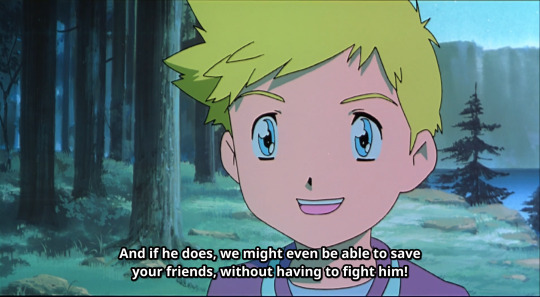
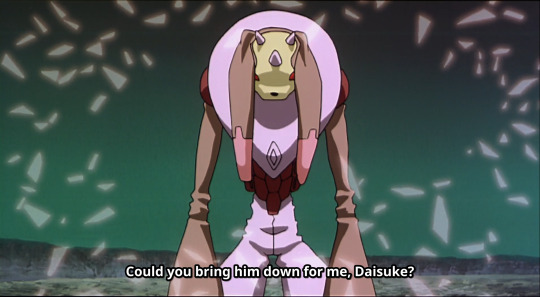


While in the series itself, they’re successfully able to save Agumon anyway, Hurricane Touchdown presents a more unfortunate outcome of the “friendly fire” debate, in which Daisuke learns that the hostile Digimon kidnapping their seniors (and, later, a lot of other people) is Wallace’s own partner. Daisuke is so emotionally overwhelmed by this that he breaks down crying at the possibility of having to kill someone’s partner, knowing that he’d never be able to do something like this if it were V-mon, and Wallace gets him on board with an attempt to appeal to Chocomon without fighting.
This stance is not unreasonable, Wallace and Daisuke cannot be blamed for being hopeful, and, in the end, it’s admirable that they did make a conscientious effort to solve this with pacifism (again, this kind of attempt should be made, and it’s not good to beeline to the most violent solution for no reason). But unfortunately, once they meet Chocomon in the flower field, it turns out that not only is Chocomon beyond reason, he himself is also clearly out of his right mind and suffering through all of this, and Wallace finally relents and asks Daisuke to assist him in the fight (after having stayed in denial for half a movie about wanting to avoid this). Daisuke, witnessing all of this himself, agrees without hesitation, and eventually, it turns out that this decision for the best when Chocomon himself begs Gumimon and Magnamon to put him out of his misery, and them obliging (albeit hesitantly) allows him to have peace in death instead of suffering in life.
Hurricane Touchdown’s sequel drama CD, The Door to Summer, presents Daisuke with yet another dilemma with Nat-chan, who is also clearly suffering in quite a similar vein (the parallel is directly drawn). In the end, the same conclusion is reached -- Nat-chan is unfortunately killed, but is able to find release.
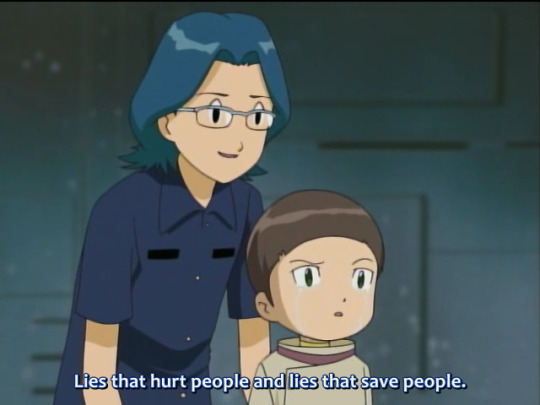
02 episode 16 presents an argument about the limits of ethical principles instead of approaching things practically, when Iori considers himself a horrible person for having told a lie to get Jou out of an important exam. This is mainly just about a lie, but in terms of Iori’s character arc and its relevance to 02′s themes as a whole, the point here is that there is a certain point where being too stuck on “the moral principle” of things instead of thinking practically is actually selfish in some sense. If Iori hadn’t lied, he’d get maybe one more point of moral integrity, and then everyone would have suffocated to death -- compared to lying and therefore everyone for the most part benefiting (Jou’s very happy to help his juniors and save them from, well, literally suffocating, after all). This topic becomes very important later when it turns out to be generally applicable to the wider morality of fighting that the kids later face in the series’s final cour.

The disparity between “moral principles” and “what actually happens in practice” also shows up in 02 episode 19, when Takeru loses his composure and starts punching out the Kaiser. Is the Kaiser a horrible person (at this point) who totally deserves this? Absolutely! Are we as the audience getting a lot of catharsis seeing his face punched out? Probably! But at the same time, railing at the Kaiser with unbridled anger is also...not actually accomplishing anything! Instead, Takeru’s just getting a few moments to stew in some really unhealthy emotions and uselessly punching out the Kaiser while nothing productive is getting done, and it’s also contributing heavily to his emotional isolation from Iori (and the rest of the group) because he’s not coping with it in a healthy way at all. Takeru’s feelings are certainly understandable (again: the episode is absolutely framing this in such a way that you’re inclined to take his side), but at the same time, being malicious about this is not actually practically making any headway.
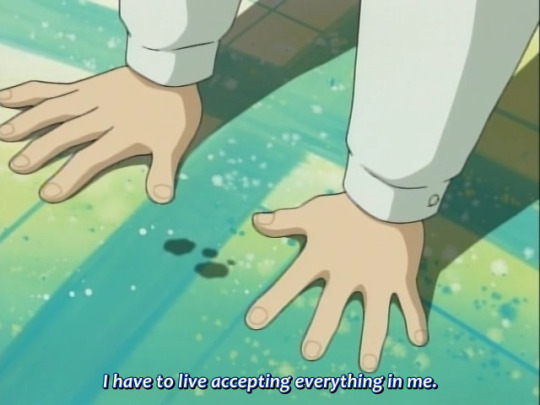
One of the major reasons I’m covering all of these seemingly unrelated topics in one post is that all of them end up having a massive combined amount of relevance to the narrative behind Ken discarding the Kaiser persona, and how he comes to integrate himself with the group. On the surface, the storyline seems to be simply that Ken learned the error of his ways and tried to stop drowning in regrets, and Daisuke’s idealistic personality reached out to him and helped him heal. That said, there’s quite a bit more going on than just that.
A theme going on behind Ken’s character arc for the second half of 02 is one that probably seems a bit unusual for an idealistic kids’ show, but the point that ends up being made quite often is that whether Ken should be “forgiven” for his actions is a rather immaterial question. 02 episode 23 has a bunch of Baby Digimon rail on him, and remind him that he will never be able to take that back. There is nothing in either world that will erase those actions or make them retroactively justified or pushed under the bridge. The only thing he can do is accept the fact that it happened, whether he likes it or not, and determine what to do from here in terms of taking responsibility and making things right.
And this ends up having an influence in how Daisuke advocates for him, and how the rest of the group reaches out to him...
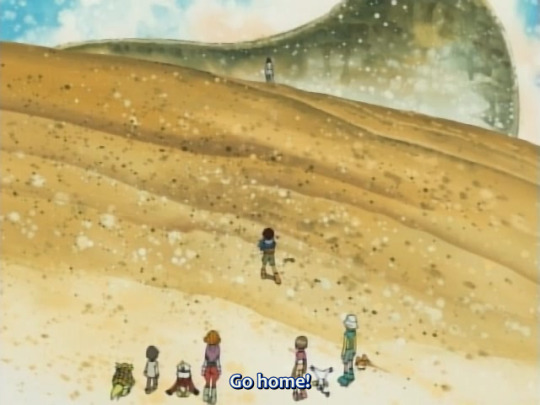
First of all, Daisuke being the most open-minded about Ken was not blind optimism. There’s no evidence that he was actually all that emotionally receptive to Ken or interested in being his friend before 02 episode 25. However, Daisuke also does not advocate for “punishing” Ken or kicking him while he’s down -- because that won’t accomplish anything, and Ken is clearly not in a state to be wreaking more havoc right now. Daisuke remembers the footage of Ken’s parents crying on screen, and determines what would be the first course of action to fix this situation -- and thus, he tells Ken to “go home”, because whatever Ken did in the past and no matter how much the team resents him right now, they are in this situation, with a boy who’s clearly not going to cause any more trouble right now and a family that’s hurting by his absence, and the very least he can do is do something productive from here on out.
Hence, at the end of 02 episode 24, when it turns out that Ken’s back and saved them from Thunderballmon, Daisuke decides to be optimistic about him and start the process of emotionally reaching out, but, again, it’s not blind optimism -- he sees what Ken did and takes this to mean “okay, clearly he’s not going to do bad things anymore, so regardless of whatever he did in the past, he’s helping out now, so we should check in with how he’s doing and let him help out.”
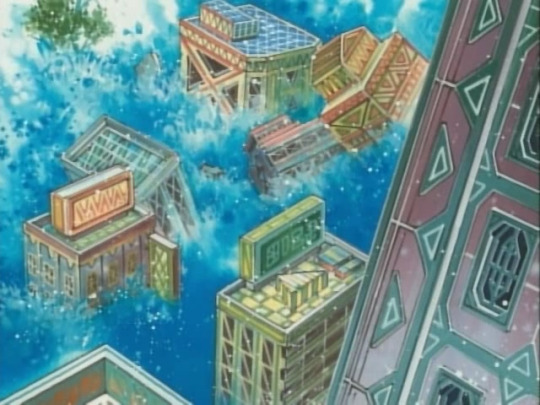

This is, of course, enhanced by the fact that Daisuke had communicated with the Crest of Kindness in 02 episode 20, but there’s also another layer to this: the major point of dispute between him and Miyako in 02 episode 25 (with both of them generally being rather open-minded about Ken otherwise) is in regards to the fact Ken and Stingmon were responsible for killing Thunderballmon in the prior episode. Come the climax of 02 episode 25, it is made clear that if Golemon successfully destroys the dam, the results will be absolutely disastrous, and there will probably be an incredible amount of casualties. Here, Daisuke himself is the first person to realize that killing Golemon may become a requirement (Ken is not actually a part of his initial comment) -- that is to say, most likely, the reason he’s willing to give Ken the benefit of the doubt about Thunderballmon is that he himself is understanding of that potential mindset (especially since 02 episode 43 does indeed establish Daisuke as being the first to accept it).
Recall that, between Daisuke, Miyako, and Iori, Daisuke was personally involved three years prior in a large incident with an unambiguously malicious Digimon that was about to claim a ton of victims -- he’s a bleeding heart, sure, but he’s also a bleeding heart for the potential victims, and the one thing that ate at him during the time of the Vamdemon incident was that he couldn’t do anything to protect everyone. Therefore, he’s the most receptive to this potential conclusion because he doesn’t want to see victims like that again. Not only that, Takeru and Hikari (having witnessed similar conclusions back in Adventure) are also very quick to point out that this might be an inevitability -- it’s just Miyako (who, in her emotional passion, is desperate to find a way out and clinging onto the hope that they won’t have to) and Iori (who considers doing such an act “no better than him” -- again, see the fixation on “moral principle” and “being above him”) who are so vehemently against it.
In the end, it turns out that Golemon is a Dark Tower Digimon (and therefore not sentient), and everyone’s left off the hook for now, but the reason this is still important is that through this, Miyako learns that Ken -- someone whom everyone was side-eyeing for potentially lapsing back into his cold, callous ways after supposedly having given up the Kaiser mantle -- was not out to kill (and, indeed, when the first kill inevitably happens in 02 episode 43, Ken is just as shaken about it as Miyako and Iori). The important part is that Miyako, and later the other kids, accepted Ken not out of some principle of optimism or forgiveness, but because they came to understand his position and feelings. All of the kids accepted Ken on their own terms after understanding his feelings and position better via interacting with him and hearing his own testimony -- they came to understand his mindset, what he’s been through and what he’s planning to do from here on out, and, most importantly, that he needs support really, really badly right now.
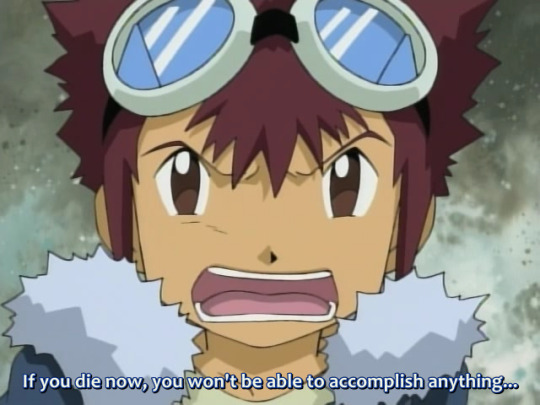

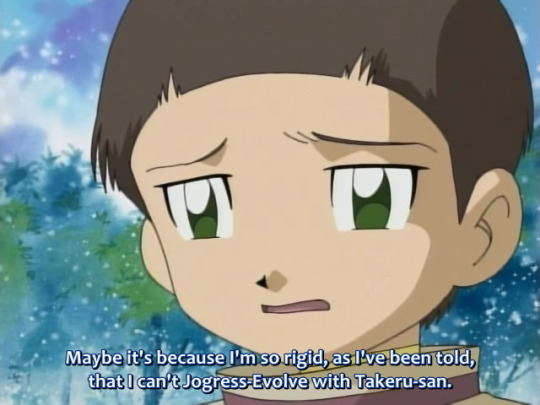
Which extends not just to Ken, but also everyone’s relationships here in general. Daisuke broke through to Ken and kicked off their first Jogress in 02 episode 26 because he proactively listened to everything Ken was saying and what he wanted to do, and correctly identified that Ken very desperately wants to take responsibility, so he talks him out of a reckless suicide mission by pointing out that all of his attempts to not make his family sad and to make up for everything he’s done are going to amount to nothing if he just throws his life away like this. In 02 episode 31, Miyako listens to Hikari’s troubles and her compulsion to not speak out for herself and reaches out to her successfully via promising to be there for her so she doesn’t have to slink into passive resignation. And in 02 episodes 34-36, Iori makes an active effort to understand Takeru’s mentality and why he has the drastic personality shifts he does, and communicates to Takeru that he wants to understand him better. So the point is: the 02 kids were able to successfully connect with each other and become deeper friends because they made an active attempt to listen to each other’s troubles and address the core of what they needed. They were only able to become “supportive” once they understood everything.
(02 episode 36 also has a moment where Iori’s about to rail off at everyone for not taking the fight seriously, before Armadimon reminds him that he’s starving -- again, it is very inhumane to ignore other needs and force everyone to keep fighting endlessly just because they theoretically can.)

We do meet the representative who claims credit for choosing Daisuke, Miyako, and Iori as Chosen Children in 02 episode 37 (Qinglongmon, representative of the Holy Beasts), and he explains the process of why they sent the kids what they did in order to retrieve Ken from the deep end. Notably, Qinglongmon admits that even the Holy Beasts were blindsided by a few things and adapted the situation as they saw fit (they didn’t originally expect the kids to be able to use multiple Digimentals at first). More importantly, this was, again, all a bit of a desperation move, because this was about as much as the Holy Beasts could manage, being sealed and drained of power and all.
Also, while retrieving Ken from the deep end was on the list of things the Holy Beasts set out to do, “everyone becoming Ken’s friend” was not necessarily on that agenda. Again: that was something that these kids chose to do on their own, by observing Ken’s actions and feelings and choosing to connect with him.
The episode ends with BlackWarGreymon going off on a journey of angst, and: note that the kids decide to drop the issue for the time being. Again, they’re operating not on a philosophy of grudge or whether one should get retribution for their actions, but what the likelihood of bad things continuing to happen is from here on out, and at this point in time, it doesn’t seem very likely, so there’s no point in pushing the issue or pursuing him.


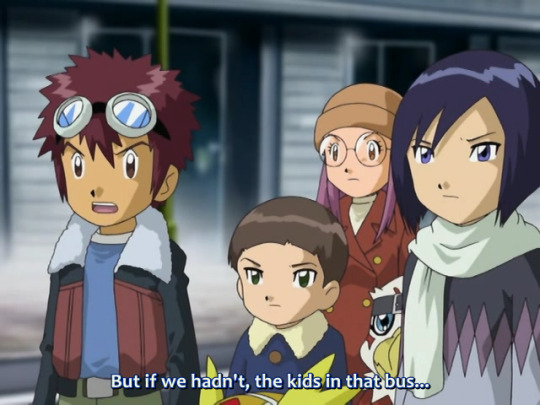
Nevertheless, the morality debate over killing still remains looming over everyone’s heads, with Iori also realizing in 02 episode 29 that there are such things as Digimon that just want wanton destruction and cannot be negotiated with. The fact that the Adventure kids were put in world-threatening situations three years prior and are already far past this question is directly acknowledged in 02 episode 43, with Taichi advising Hikari that this harsh truth is going to hit the other four sooner or later, before it does eventually happen at the end of the episode. (Hikari visibly winces during her conversation with Taichi; again, none of the Adventure kids ever liked this.) And, in the end, predictably, Iori, Miyako, and Ken take it hard -- but Daisuke is the first to point out what would have happened if they didn’t do it. Namely, that the victims would have far outnumbered the Digimon they just killed.
It is, of course, good to be conscientious and not beeline for the most violent solution, and, again, context is important here -- in the situation provided, SkullSatamon was holding up a bus and split seconds away from murdering everyone in it. Had everyone refrained for the sake of morality, just like how Iori refraining from lying back in 02 episode 16 would have actually been selfish in a sense, here, the only claim you get to say after refraining is “well, I wasn’t the one who caused the harm.” Inaction would have caused the deaths of all of the young children in the bus; there would have been casualties either way.
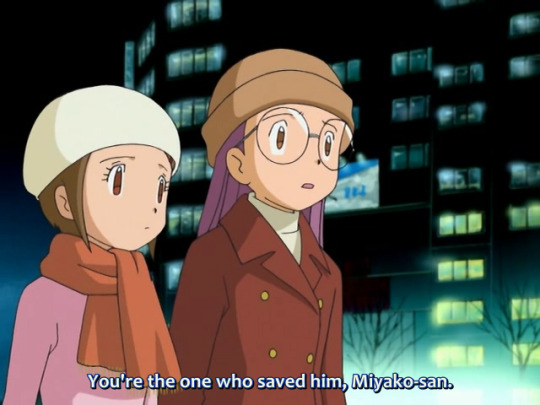

Miyako and Iori are forced to face this truth again in 02 episode 44, with both of them being emotionally compromised by the reality of what they just did. In both cases, Hikari and Takeru step in to remind them what they’re doing this for, by pointing out the victims that would have been killed had they done nothing. Miyako and Iori are not at fault for being emotionally compromised or doing their best to prevent it -- it’s just that there’s only so much they can blame themselves for when they’re now directly faced with the potential victims in front of them.
Iori had already been grappling with this potential for several episodes now, so while he still takes it hard, more attention is given to Miyako’s reaction -- especially since she herself was the victim who was about to be murdered by LadyDevimon had Silphymon not done the kill. The voice acting and lack of Tailmon’s presence in Silphymon’s apology to Miyako implies very heavily that it was the Aquilamon side who took over and did it in a last-ditch effort to save Miyako’s life -- and he’s emotionally destroyed by it himself too, because he did it out of love for Miyako, and yet betrayed her request to not go for the kill. In the end, Miyako is forced to confront the fact that this was done out of love and a desire to protect, not a callous and malicious intent to murder, and comes to terms with it.
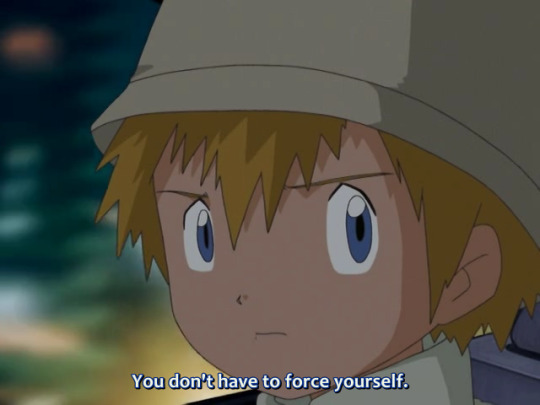
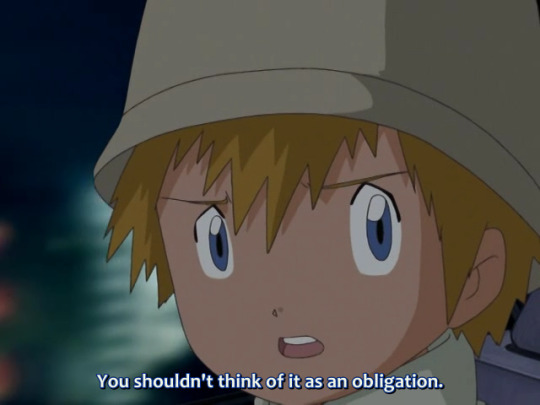

However, again: the series continues to reiterate that people who are not emotionally up for it should not be obligated to force themselves to do it. The beginning of 02 episode 45 has Takeru directly advise Iori that he shouldn’t do this out of obligation if he isn’t up for it -- remember that Takeru will only be able to fight with Shakkoumon if Iori is present, meaning that he’s perfectly willing to give up his ability to fight effectively because it’s not fair to force Iori to do it. This is not a series that advertises that everyone embrace the spirit of killing things and numb themselves to it. This entire situation sucks.
However, Iori makes it clear: he understands everything, and has decided to do it himself, because he understands the stakes and what it’s going to take to actually protect people.
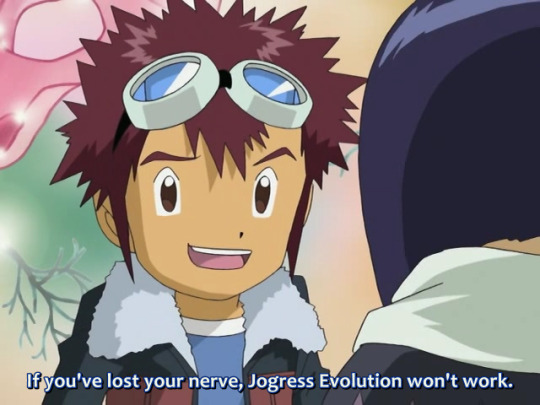
Which is also reiterated in 02 episode 48 -- after witnessing the deaths of Archnemon and Mummymon at the hands of BelialVamdemon, everyone is shaken to the core. It should be established that the kids didn’t have much reason to sympathize with or like the two of them at this point, because everything we learned about them was from the audience’s point of view -- as far as the kids knew them, they were just two really rude and cruel Digimon who wanted wanton destruction. Yet even they are emotionally pained to see them die in such a cruel manner, and it causes everyone to hesitate -- even Daisuke, who does push forward because he knows what’s at stake, but still has to take a moment to collect himself.
Seeing what Daisuke’s about to do, Ken tries to force himself to join Daisuke so that Daisuke will at least not be alone (note that he actually says upfront that he’ll join!) -- but Daisuke notices that Ken’s heart isn’t in it, and actively advises him to sit out. Is the world in immediate crisis? Absolutely! But there is no scorn to be had for people who are emotionally falling apart right now and unable to get themselves to do it -- Daisuke even says himself that they won’t be able to fight effectively with Ken like this.
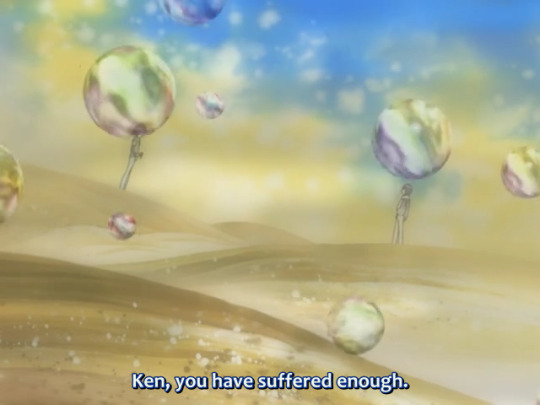

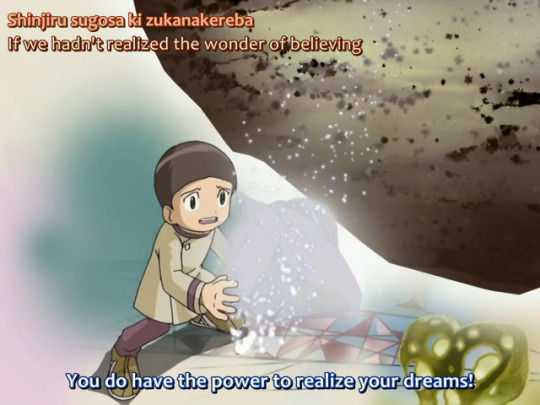
We close this analysis on a return to the concept of forgiveness and moving forward, and we learn in 02 episode 48 that Ken has two parts to his internal wishes: he wants the Kaiser (himself) to be “punished”, and he wants “forgiveness” from his deceased brother Osamu. Both of those things will certainly make him feel a little better emotionally, but they also won’t accomplish anything -- the “Kaiser” doesn’t exist anymore, so what good will that “punishment” do besides a little catharsis for the victims? And he can continue chasing after this standard of “whether he’s suffered enough” like it’s some numerical tally, but that’s not going to get him anywhere either, and it’s why Wormmon has to chase out even that ostensibly happy image of Osamu. Osamu is long gone, and is not going to return, and the question of whether Ken should be “forgiven” is rather immaterial. It’s not about whatever happened or didn’t happen back then; it’s about what Ken is going to do now.
Actually, what is “forgiveness” anyway? At no point do the 02 kids ever actually say they “forgive” Ken for his actions. In Spring 2003, Iori also says he doesn’t forgive Oikawa for what he’s done, either. There’s nothing that will ever erase what they did or suddenly make those actions retroactively justifiable, and there’s no arbitrary payment that Ken or Oikawa could do to meet some kind of quota of forgiveness. But what the kids do recognize in Ken is that, regardless of whatever he did in the past, at current he is a young boy in intense emotional distress who has gone through a lot, is working very hard to make up for his mistakes, and needs all the emotional support he can get, and there’s no reason to hold a grudge against someone like that instead of continuing to support him and loving him for who he is now. Given that, does it matter whether they “forgive” him or not?
And even if Iori will never forgive Oikawa, he can still lament everything that happened to him and drove him to do everything, and appreciate the meaning of what he did for the Digital World in the end, and use this as a further lesson on what it means to understand people instead of stewing angrily in a grudge that’ll only hurt himself.
Ultimately, that is the theory behind Adventure and 02. The world is messy, imperfect, and doesn’t fit under neat rules of morality and “right” or “not right” that you can cram everything under. Despite that, there’s something to be appreciated in not throwing in the towel and continuing to do the best you reasonably can in every situation. It would be ideal if all of the fighting could stop, or if it were possible to make the “optimal” decision of fighting or not fighting in every situation regardless of human exhaustion or emotional compromise, but that’s just not something that’s possible, and there’s no reason to call oneself a “failure” for not holding yourself to that standard. And in the end, the answer is this: instead of fixating on all of those arbitrary things that don’t actually serve any practical purpose, the way to live your best life is simply to look at where you are now, think about what you can do from here on out (regardless of what happened in the past), and do your best to protect and be kind to yourself and those around you.
Of course, you must be kind to others. But you have to be kind to others by understanding what it takes and everything around it -- and then choose to be kind anyway.
121 notes
·
View notes
Text
where is hawai'i? can you point to it on a map?
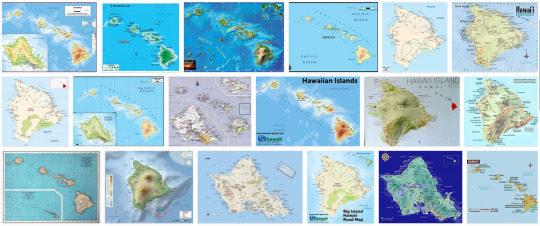
if someone asks you to point to hawai'i on a map, where would you point?
before colonization, there was (and continues to be) an island called "hawai'i". the entire chain of islands is called "hawaii" and there is a state called "hawaii" made up of a large number of those islands.
now, because there are too many things named "hawaii," the island of hawai'i is often called "the big island", because o'ahu, the island where the city of honolulu is located, is what many people think of when they think of "hawaii". it's a mess.
on top of that, we have the "main hawaiian islands" (aka "southeastern islands" aka "windward islands") vs the "outer islands" (aka "northwestern islands" aka "leeward islands").
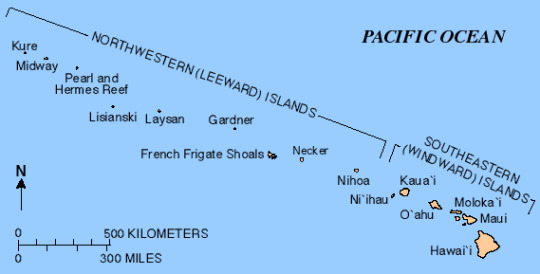
most maps of "hawaii" show only the "main" islands. the map above (created by USGS) shows more of the hawaiian islands, but omits the names of two of the islands in the "main" chain: lana'i & kaho'olawe. these are not insignificant omissions. lana'i is 98% owned by larry ellison, founder & chairman of oracle corporation. kaho'olawe has been relentlessly used & abused by the west. it has been used for ranchland, military training, and most notably, as a munitions testing site, resulting in the continued contamination of the island. after many years of protests & lawsuits by native hawaiians, the island is now only accessible by native hawaiians for cultural, spiritual, & subsistence reasons.
meanwhile, this tourist mug with a creepy colonial-style map of hawaii includes both kaho'olawe & lana'i. good job, tourist mug!

there are actually over a hundred islands in the hawaiian archipelago. the state of hawaii includes 137 of them (source). midway atoll (made up of 3 islands) is part of the archipelago, but not part of the state. it is one of america's territories: an unorganized unincorporated territory.
additionally, some of the islands "are too small to appear on maps, and others, such as Maro Reef, only appear above the water's surface during times of low tide. Others, such as Shark and Skate islands, have completely eroded away." [source: wikipedia page "list of islands of hawaii"].
in the course of writing this post, i failed to find a map that shows & names all the hawaiian islands and failed to even find a list of all of them (plus if an island only appears sometimes or has disappeared entirely, what do you even do with that?). if you find either or both of those, let me know in comments.
so where and what "hawaii" is remains a mystery.
but this has not prevented commercial & official interests from using maps of "hawaii" in all kinds of places! here on the islands, hawaii map imagery is all around.
maps are very common on tourist items:
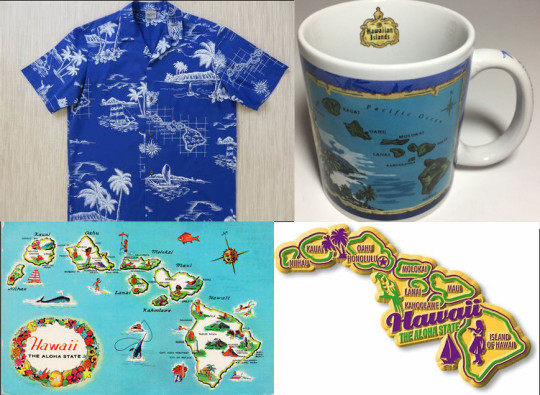
the hawaiian telcom logo uses dots roughly arranged in the pattern of the islands on a map:

but i guess only five islands are worth including (i understand. branding needs come above all else!).
this souvenir cloth item is interesting because it includes all the main islands (including ni'ihau, lana'i, and kaho'olawe - which are often excluded), but smooshes them into the available space without much consideration for where they are in relation to each other:
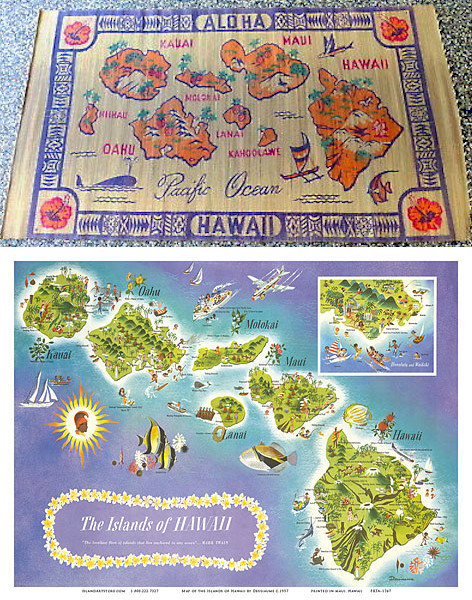
the postcard above has the main islands in their rough places, but squishes them all together so that they fit in the space. also the islands are made more similar in size to each other so that you can better see the little illustrations.
here's a more "official" map to show where the islands "should be" in relation to each other, and their sizes relative to each other (although both of those can change depending on what projection the map uses):
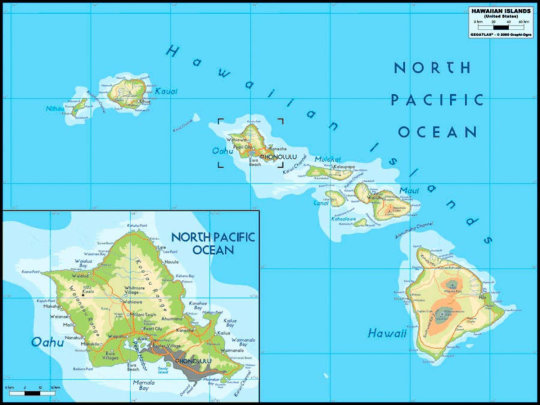
in my mind, though, the ultimate hawaii map fantasy lives on the ubiquitous reusable walmart cloth bag (available for 50 cents at checkout to all who have forgotten to bring the right number of bags. there's a plastic shopping bag ban in hawaii.):

in the walmart commercial universe (wcu), the only islands that exist are islands that have a walmart. the general outlines of the islands & their general orientation is preserved (along with a rough topology too!), attempting to convey a sense of adhering to a recognizable reality, but islands without a walmart have been not only omitted, but the space where they would be has been eliminated as well - as if they were never there to begin with. in the walmart version of reality, what makes something "hawaii" is whether or not it has a walmart on it.
i've had a lot of time to think about this remarkable image because i have a whole bunch of these bags. this is the bag of the people - everyone uses it for everything. the one in the above photo is in a typical state - pretty rough - because it probably came from the side of the road. you can almost always find one on the side of the road. so wherever you are, you are probably within sight of the walmart version of the islands.
so why does it matter whether or not you can point to "hawaii" on a map? well, maps are political documents, meaning that they reflect the vision of whoever has the power to put the map in front of your eyes. so if you're the one with the power to make some of the most commonly-seen maps of hawaii and you decide to remove a few islands, well that can really shape what people think "hawaii" is! we're a sea of islands - many people here have only ever been to one or two of the islands. if it wasn't on the map, you might not know that it existed at all.
hawaii is incredibly important to the united states, not just for tourism, but in terms of global strategy. it's the largest outpost of american power in the middle of the pacific. it puts america & its troops half an ocean closer to some of america's biggest competitors, most notably, china. it's a springboard to all the other island territories of the pacific (which you maybe haven't heard of because they almost never appear on maps):

once you see a map of all of america's territories in the pacific, along with the exclusive economic zones (eez) that extend out for 200 miles around each island, you start to get a better feel for the extent of america's power in the pacific.
when a place is left off the map, it can be easy to make it (including its people!) invisible. so if you're america, with bases across the islands of the pacific, with a nightmarish history of atomic weapons testing in the pacific (rendering islands uninhabitable and leaving both land and waters too contaminated for people to use), perhaps you might not want some of these places to appear on the map.
in Foreign Policy in Focus, Khury Petersen-Smith writes:
"Many of us living in North America who are concerned about climate change, for example, have a sense that Pacific Islands are facing particularly severe impacts from rising sea levels. But that knowledge tends to be vague and limited, as actual residents of these islands are rarely invited to the table to speak for themselves.
This is not accidental. Commenting during the Nixon administration on U.S. nuclear testing in the Marshall Islands, which share the same region of the Pacific as Guam, Henry Kissinger said “there are only 90,000 people out there. Who gives a damn?”
The U.S. has long had an interest in Marshallese and other Pacific Islanders remaining “out there” in the American mind. This marginalization helps allow the U.S. to carry out military operations in the region, along with policies that further climate change and other harms, while keeping most Americans unaware of these practices’ impacts in the Pacific." [FPIF]
often hawai'i (and alaska - which is in many ways similar to hawai'i in its relation to the contiguous US) doesn't even appear on national maps of the USA.
here's a screenshot from the new york times homepage on march 21, 2020, just as the coronavirus pandemic was beginning to spread:
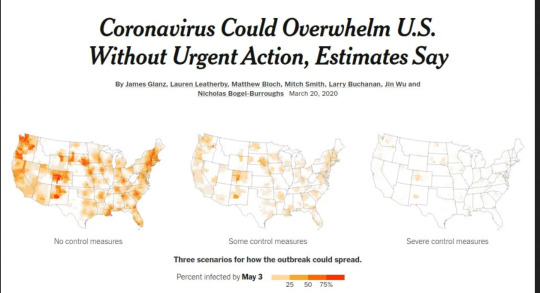
there is no alaska and no hawai'i on those maps. so if you were looking for information on the most important issue that was happening at the time, and you live in or are concerned about hawai'i and/or alaska, there would just be nothing. and what does it say about the people who run the top newspaper in america that they decided it was fine to omit these two states? are they not states? do they not matter? do the readers in those states not matter? and this is not an unusual thing at all. it happens all the time.
i'd like to finish by sharing with you a poem by CHamoru poet Craig Santos Perez. CHamoru are the indigenous people of the mariana islands (which include guam, saipan, tinian, rota, and others).
in this poem, Craig Santos Perez writes about not appearing on the map...
“Off-Island CHamorus”
My family migrated to California when I was 15 years old. During the first day at my new high school, the homeroom teacher asked: “Where are you from?” “The Mariana Islands,” I answered. He replied: “I’ve never heard of that place. Prove it exists.” And when I stepped in front of the world map on the wall, it transformed into a mirror: the Pacific Ocean, like my body, was split in two and flayed to the margins. I found Australia, then the Philippines, then Japan. I pointed to an empty space between them and said: “I’m from this invisible archipelago.” Everyone laughed. And even though I descend from oceanic navigators, I felt so lost, shipwrecked
on the coast of a strange continent. “Are you a citizen?” he probed. “Yes. My island, Guam, is a U.S. territory.” We attend American schools, eat American food, listen to American music, watch American movies and television, play American sports, learn American history, dream American dreams, and die in American wars. “You speak English well,” he proclaimed, “with almost no accent.” And isn’t that what it means to be a diasporic CHamoru: to feel foreign in a domestic sense.
Over the last 50 years, CHamorus have migrated to escape the violent memories of war; to seek jobs, schools hospitals, adventure, and love; but most of all, we’ve migrated for military service, deployed and stationed to bases around the world. According to the 2010 census, 44,000 CHamorus live in California, 15,000 in Washington, 10,000 in Texas, 7,000 in Hawaii, and 70,000 more in every other state and even in Puerto Rico. We are the most “geographically dispersed” Pacific Islander population within the United States, and off-island CHamorus now outnumber our on-island kin, with generations having been born away from our ancestral homelands, including my daughters.
Some of us will be able to return home for holidays, weddings, and funerals; others won’t be able to afford the expensive plane ticket to the Western Pacific. Years and even decades might pass between trips, and each visit will feel too short. We’ll lose contact with family and friends, and the island will continue to change until it becomes unfamiliar to us. And isn’t that, too, what it means to be a diasporic CHamoru: to feel foreign in your own homeland.
Even after 25 years, there are still times I feel adrift, without itinerary or destination. When I wonder: What if we stayed? What if we return? When the undertow of these questions begins pulling you out to sea, remember: migration flows through our blood like the aerial roots of the banyan tree. Remember: our ancestors taught us how to carry our culture in the canoes of our bodies. Remember: our people, scattered like stars, form new constellations when we gather. Remember: home is not simply a house, village, or island; home is an archipelago of belonging.
–Craig Santos Perez
----------
thank you for reading this post! please let me know if you see any errors.
if you'd like to learn more about some important issues in the pacific, here are just a few:
july 2, 2020: "US says leaking nuclear waste dome is safe; Marshall Islands leaders don't believe it" - Los Angeles Times
may 30, 2021: "Pacific Plunder: this is who profits from the mass extraction of the region's natural resources." - The Guardian
april 5, 2021: "75 years after nuclear testing in the Pacific began, the fallout continues to wreak havoc" - The Conversation
june 4, 2021: "Guam won’t give up more land to the U.S. military without a fight" - The World (radio program)
aug. 24, 2021: "The US is building a military base in the middle of the Pacific Ocean. Micronesian residents have questions." - The World (radio program)
and if you'd like to learn more about how maps are political, here are a couple articles:
june 5, 2014: "The politics of making maps" by Amanda Ruggeri, for BBC
july 11, 2018: "Politics and Cartography: The Power of Deception through Distortion" by John Erskine, for the Carnegie Ethics Online Monthly Column
24 notes
·
View notes
Text
A long ramble of thoughts about the history of chaos on the continent and why Fringilla’s use of forbidden magics is pretty neat
So one thing not too many people knowing about the Witcher is that magic is called Chaos for a very specific reason: it is the opposite of Order. In Sword of Destiny, Borch tells Geralt that Chaos is the aggressor and Order is endangered and needs protecting. Chaos is what mages/elves/witchers/sources/etc can channel in order to produce magic.
It's important to note that magic DID NOT EXIST before the conjunction of the spheres so it's pretty strongly implied that before the conjunction Order and Chaos were one and the Conjunction split them apart, leaving Order vulnerable and Chaos in the hands of living beings to manipulate. When the conjunction happened, no race (humans, elves, werebubbs, etc) knew how to use magic but eventually most of them found a way to use chaos.
What is interesting is that we are told that Witchers/Mages/Elves all see magic differently but we are never told how. It is mentioned briefly that mages "pervert" magic by the Elves but we don't know what perversion of magic looks like to the elves because it is subjective to their own worldview. However, looking at the earliest human tribes on the continent, the Dauk and the Wozgor we can get some idea of the difference between human magic and elf magic. Both groups were very influenced by ritualistic group magic as well as worship of the gods. Many of these gods such as Melitele are still worshipped.
The Dauk were more into fertility and harvest, think early Beltane Midsummer stuff, while the Wozgor primarily worshipped Lilit with Blood Sacrifices. So we see humans are in a group-mentality when it comes to magic and summoning, they pull power from the earth and pool together their magic to create spells. At this time, elves and humans were not considered enemies so group-magic and more nature-esque magic is accepted by the elves. This is also supported by the dryads and elves seeming to prefer druids who still use magic group-magic today.
So now we start to get into when the philosophical schism on magic happened. Clearly, at some point, humans started working on less "group/nature magic" and on more individualistic magic. By the nature of chaos it is consuming so as more humans began working on individual magic, they became more power hungry. I had a theory that it was human's use of individualized magic that led them to leaving the nomadic tribe mentality and instead moving to more Nordling-Like culture where they live in one place and fight with other tribes, eventually building cities, colonizing, and in general taking the standard course of human history. So now humans have magic. And they have POWER.
So you get mages who are fighting for their tribes, their groups and eventually kingdoms like Novigrad begin to form. Now the Brotherhood was formed in the 8th century by the Novigrad Union which was a group of druids, mages, and priests who signed a non-agression pact to stop the raids and warfare that were so common for centuries. However, the Union fell apart due to difference in views on magic while the Brotherhood stayed together.
The Brotherhood is now sort of the ruling party on the continent, it's the only power really left after the Union. It's not its own Kingdom so it can technically be considered neutral. This puts a lot of responsibility on the Brotherhood and the Northern Rulers are overwhelmed by the number of monsters. Previously, humans were so focused on killing each other they couldn't really organize and do anything about the monsters but now that society is developing it's a real problem for trade and travel. so they create the first Witchers in Rissberg. However, once they find out that the Witcher don't have the same magic aptitude as mages, they are discarded as failed experiments.
This is where is gets interesting again for me. Because Witchers actually can cast magic as strong as mages, they elect to use signs but Witchers can pool their magic together in order to cast more powerful spells. So what was the difference between mages and witcher that had the mages deem Witchers as failures? I am theorizing that Witchers channel chaos whereas mages manipulate it.
The way I describe it in my fic is that Witchers act as a conduit for chaos, think of it like sucking up magic into a straw, the Witcher is the straw, they bring chaos in it's purest form into the world. Then, once the magic is in our realm, they shape it into the spell or form they desire. It's similar to how elves and ancient humans used magic. This is why the elves don't call a Witcher's magic a perversion but a mage's magic is.
I'm theorizing that Mages on the the other hand bring magic in through almost a mold. When a mage summons chaos, that chaos can only be used for the very specific purpose that they want in that moment. It ties into their philosophy on willpower. What you desire is the magic you have. So a Witcher could begin to cast an Aard and then halfway through change the sign into an Igni and it would work fine. However, a mage can't begin to cast a portal and then change it into a lightning bolt. But this is also the reason mages are so powerful, their magic is specific. It is decided and the willpower behind it makes it a stronger spell.
NOW FINALLY we can begin talking about forbidden magics. So I'm not going to get into the First and Second Ages of the Witchers but just know that Witchers are now off on the continent doing their own thing and monster hunting, creating their own culture, etc. The Brotherhood does NOT care for this. They can see control slipping from their fingers so they and they are worried other mages are going to experiment the same way they experimented to create Witchers but this time they will make something even more powerful. Something that could topple their power.
The Brotherhood begins to ban magic that could be used to manipulate the natural order. The main three banned magics of the Brotherhood are Goetia (demonology), Necromancy and Ancient Magics. Now demonology was actually practiced by the Wozgor and many think that Lilit was actually a demon they summoned. Necromancy and Ancient Magics both have the potential for abuse but not more so than any other form of magic. However these are all powerful magics. But it's not just BANNING magic that creates censure with the brotherhood. It's the stringent guidelines of how to perform magic even though we KNOW there are multiple ways to channel chaos. The Brotherhood also creates a system with the court that also creates censure because courtly expectations now place an emphasis on respectability and governance and how you should hold yourself, etc. Being a mage becomes a lot more restrictive and a lot less experimental.
So we have to ask ourselves, what does Fringilla do that causes her to be considered abhorrent, In Tissaia's words: "I will defend our way of life, The Brotherhood, The Academies, the order that we have built up over centuries, you've rejected it all Fringilla"
So here's what we KNOW Fringilla has done: Forced Mages in Servitude until they decide to serve the White Flame (of course Fringilla says it isn't servitude but Triss disagrees), Practice Necromancy, Demonology, and Fire Magics She specifically says the phrase "most of us came from Aretuza and Ban Ard" so here's what we have to consider, how did Fringilla get them there, she can't have kidnapped everyone and as well if u know some spoilers from the book then there are plenty of mages that voluntary work for Nilfgaard.
Fringilla works with ANYONE who has chaos, not just people deemed worthy by the Brotherhood. In addition, she works will all magic, no limitations. In many ways, Nilfgaardian magic is returning to ancient magic. If you watch the battle at Sodden, the mages perform a lot of life-force spells. I have a theory that those types of spells are MEANT to be performed in groups and since they aren't, the mage withers and dies.
Also, listen, in another world Nilfgaard could be the hero. If they didn't show Nilfgaard being generally evil like killing everyone and sacrificing mages and stuff they actually have good reasoning? Cintra is objectively terrible. They literally almost killed off an entire race? The Genocide of the Elves is very much brushed over and honestly Cintra should have been overthrown ages ago. Also Nilfgaard has policies of cooperativity and community and honestly if they didn't so morally bereft acts their society has a lot of potential.
Fringilla is returning magic to how to was pre-brotherhood where it's groups of loosely defined mages doing what they want. She is also trying to break of the individualistic mindset of most mages which I think is interesting because it goes against the very soul of how mages perform magic. It's like Tissaia said, Fringilla is rejecting centuries of tradition. In any other world, Fringilla would be the Katniss to the Brotherhood's Capital. If Nilfgaard wasn't cast as so brutal they would literally be considered a revolutionary force trying to oust a genocidal dictatorial system (Cintra). Granted, many people have compared Nilfgaard to either being a Roman Empire or Soviet Russia analog, both brutal totalitarian or imperial regimes which probably is part of the reason Nilfgaard is so brutal. I am suggesting that in another universe, Nilfgaard could be instead of an imperial-religious-type regime a more revolutionary force.
Perhaps an AU where Nilfgaard teams up with Cintran Rebels and arrives at the city to help Cintran Freedom Fighters tear it down and then allows Cintra to rebuild on their own terms. Basically, I’m talking about the overthrow of the monarchy system present in most of the continent.
I would really like to see an AU where Fringilla is a revolutionary figurehead trying to work to establish a democratic system in a monarchal society while going against centuries of magical tradition. I think with the addition of magic and complexity of politics not the continent there’s just so much to think about here.
#listen#if anyone#and I mean literally anyone#read to the end of this you are a hero#I know a lot of world building stuff about the Witcher and I like to talk about it#honestly I might write out this Fringilla thing myself#cause fucking hell it sounds very cool once I said it#but I have no time for WIPs#whatever#I don't care#let's GO#lemme know if you liked this at all#the witcher#fringilla#worldbuilding#nilfgaard#cintra#myposts
79 notes
·
View notes
Text
Genetic Study Maps When and How Polynesians Settled the Pacific Islands
https://sciencespies.com/nature/genetic-study-maps-when-and-how-polynesians-settled-the-pacific-islands/
Genetic Study Maps When and How Polynesians Settled the Pacific Islands


Moai statues at the Rano Raraku site on Easter Island Weller / ullstein bild via Getty Images
Gazing across the sea for days on end Polynesian navigators often didn’t look for land, which was hundreds of miles away in any direction. Instead, they watched the stars, clouds, birds, waves and other features of the environment from their open canoes, using them to navigate from one unseen island to the next, repeatedly finding green specks of land in a blue sea that covers one-third of the planet. Eventually these great explorers populated the habitable islands of the vast Pacific and left future generations to wonder exactly how it happened.
The ancient voyagers left behind only faint traces for scientists to reconstruct some of humankind’s most adventurous journeys. Those things include clearly related languages on widely scattered island groups, sweet potatoes, stone tools and even, in a few places, towering human figures. Those stone monoliths have stoically stood for centuries, bearing witness to the skill of their sculptors but offering few clues to who those ancient islanders were, or how they got there.
But in recent years it has become clear that the Polynesians left something else behind—their genes. Searching the genomes of humans on widely scattered islands and tracking changes has allowed scientists to map their epic journeys in time and space. Now, new research published today in Nature makes the intriguing suggestion that the Polynesians who erected those mysterious stone figures on islands thousands of miles apart were actually descended from the same group of explorers. “The fact that we find genetic connections between very different islands, but the factor that they have in common is the presence of this culture of megalithic statues, I think is a pretty surprising thing that genetics is helping us to discover,” says Andres Moreno-Estrada, with the National Laboratory of Genomics for Biodiversity in Mexico, an author of the new study.
Some of the same facts that made settlement of the Pacific such a challenge also created an unusual genetic history that has proven ideal for recreating Polynesian ancestries, and thus charting their voyages generally eastward across the ocean. Pacific islands are so widely scattered that humans lived on them in genetic isolation, and travel between islands by canoe was necessarily undertaken by small groups of perhaps 30 to 200 individuals, who formed a very small founding population on each new island that they reached.
Moreno-Estrada and colleagues tracked Polynesian ancestry by gathering genome wide data from 430 modern individuals in 21 key Pacific island populations from Samoa to Easter Island. Then they used computational analyses on these large numbers of modern genomes to track genetic variants down through the generations. Most rare genetic variants found in each settled island’s population weren’t carried by any of the individuals who made trips to future islands, and thus don’t appear in the genome of the new island’s population. Scientists can track the loss of these variants. And occasionally a few rare variations did move along to each new island, by chance, with an individual in that small founding population. Once on the new island those previously rare variants were soon acquired by all descendants of the small founding population and became extremely common, providing another genetic marker.
Tracking these key ancestral signals allowed the team to map human movement across the Pacific islands, and produce date estimates for settlement journeys by calculating the number of generations between genetic divergences.
“The genetic method used takes advantage of the serial bottlenecks that population experienced while settling subsequent Eastern Polynesian islands,” says Cosimo Posth, an expert in archaeogenetics at the University of Tübingen who wasn’t involved in the research. “This provides very good evidence for the order of the expansion.”
Modern genetic influences from Europeans, Africans and others exist on some islands but the team was able to use machine learning techniques to mask these pieces of the genome and compare only the Polynesian parts of the ancestry evidenced in the genetic code.
And on islands for which ancient DNA samples exist, the team compared them to modern genomes and learned that individuals living on those islands remain most closely related to ancient samples from the same island, confirming that the original population hasn’t been largely replaced by some later migration of different groups.
The findings chart a Polynesian settlement of the vast Pacific that began in the western Pacific, in Samoa. With their distinctive double canoes Polynesians then reached the Cook Islands (Rarotonga) in the ninth century, the Society Islands (Tōtaiete mā) by the 11th century and the western Austral (Tuha’a Pae) Islands and Tuāmotu Archipelago in the 12th century.

Illustrated above are distinctive monolithic sculptures crafted by the inhabitants of the Marquesas Islands (top), Mangareva (center), Raivavae (bottom left) and Rapa Nui (bottom right)
Zaira Zamudio López
Patrick Kirch, a historical anthropologist at the University of Hawai’i, Manoa, says the study is a good example of how evidence from linguistics, archaeological dating of habitation sites and artifacts and genetics are converging to paint a similar picture of Polynesian settlement. “They’re giving pretty precise estimates of colonization dates and in general those are fitting quite nicely with our new radiocarbon dating [of habitation sites] of the last 10 or 15 years,” says Kirch, who wasn’t affiliated with the research.
Most intriguingly, the authors suggest that the Tuāmotu Archipelago, a group of low-lying, sandy atolls that hasn’t yielded much in the way of archaeological sites, may have been home to populations of long-distance seafarers who went on to settle the Marquesas Islands (Te Henua ‘Enana) in the north, Raivavae in the south and Easter Island (Rapa Nui) by about 1200 A.D. On each of these extremely distant islands someone, settlers who shared the same ancestors according to the study, left behind a similar culture of remarkable stone monoliths. Those human images have stoically and mutely stood as testament to the humans who erected them—and perplexed later visitors searching for their origin.
Co-author Alexander Ioannidis, who studies genomics and population genetics at Stanford University, wasn’t even aware that Raivavae had stone figures like those on Easter Island. “We found the genetic connection first,” he says. “I was really shocked that this island we had found was genetically connected, but isn’t really well known, [and] also turns out to also have these huge statues.”
Patrick Kirch says the theory that one group of closely related Polynesians took monolith culture with them to far-flung islands over several centuries, will likely prove more controversial. Only a handful of islands host large stone monoliths but many others, like Hawaii, feature similar human images carved in wood, he notes.
“In my view it’s more a matter of carving human images, for various religious purposes or ancestor worship. So it’s a widespread cultural practice in East Polynesia, and just because some of them are in stone I don’t think we should necessarily make too much of that.”
Previous genetic research by the study’s authors concluded that Polynesians and Native Americans first met around the year 1200 in the remote South Marquesas, and the new research suggests that voyagers from the Tuāmotu Archipelago were the ones who settled those same islands during that same era.
It’s not known whether Native Americans ventured into East Polynesia, where the two groups met, or whether the settlers of South Marquesas already carried Native American genes circa 1200 because they’d first reached that distant continent. That raises the interesting possibility that Polynesians extended their eastward travels from Tuāmotu to the very end of the ocean.
The tale of Polynesian voyaging isn’t a simple linear progression in which settlers advanced across the Pacific from one island to the next. For example, they likely passed by Raivavae on their general eastward migration, and settled it some three centuries later by heading back to the west from Mangareva.
Polynesians also didn’t immediately give up long distance seafaring just because they had found and settled plentiful new islands. The study of language evolution suggests that there was considerable inter-island contact during the era when Eastern Polynesia was settled.
And some more concrete facts have also emerged as archaeologists have developed new techniques. X-ray fluorescence traces the stone tools found on numerous islands to specific query sources in the Marquesas and Austral Islands, showing that adzes and other tools were taken to far flung islands on long canoe voyages. “The archaeological evidence for inter-island contact now is very strong and people were moving around between these islands after they were settled,” Kirch says.
The question is how much those post-settlement voyages might have contributed to the genetic makeup of the individuals living on the islands today, and thus impacted the study conclusions inferred from their DNA.
The authors acknowledge that subsequent voyages between the islands occurred, but believe that in most cases they didn’t have significant impacts on genetics because of exponential population growth. When small groups of 30 to 200 individuals reached new islands stocked with nesting seabird colonies and unfished reefs, their populations likely boomed to thousands of closely related individuals sharing similar genetics. When a few double canoes later occasionally traveled thousands of ocean miles, carrying perhaps a few dozen individuals, they would likely have had little impact on the genetic frequencies of islands where they landed.
The picture drawn by Polynesian genetics doesn’t always agree perfectly with archaeological evidence. Estimates for the settlement of Marquesas, for example, are a few hundred years later than the earliest radiocarbon dating evidence of charcoal samples found at habitations in the Northern Marquesas.
For the most part, however independent lines of genetic, linguistic and archaeological evidence are generally converging to tell a similar story of what’s called the ‘short chronology’ of Eastern Polynesia. And there are more chapters to write. The Pacific is vast, and even genetic exploration of its islands and their settlers takes a lot of time and effort.
Moreno-Estrada’s team is next turning their attention to a group of islands with a high profile. “Who were the first settlers of Hawaii and where did those people come from,” he wonders. “That’s an open question we are going to explore.”
Explorers
Genetics
Indigenous Peoples
Pacific Ocean
Ships
#Nature
#09-2021 Science News#2021 Science News#acts of science#Earth Environment#earth science#Environment and Nature#Nature Science#News Science Spies#Our Nature#planetary science#Science#Science Channel#science documentary#Science News#Science Spies#Science Spies News#Space Physics & Nature#Space Science#Nature
8 notes
·
View notes
Photo

(Princess) Kinkajou of the RainWings
I want to believe that Kinkajou is actually a biological descendant of Grandeur, but it doesn’t truly matter because she was supporting Glory for the throne and heritage does not equal merit. Kinkajou is fascinating character who took so many punches yet shes never properly thanked or appreciated for them? I think Kinkajou ought to be more painfully optimistic. As a partial foil to Sunny. She’s not optimistic because she NEEDS to be the one keeping the group optimistic. Kinkajou remains happy because of somewhat emotionally stunting double standards in the RainWing queendom and the act that tears only get you so far. Confidence and energy is what people respond to.
Kinkajou deserves so much more than what canon gave her. Tui might have said “her story is over,” but I seriously disagree. Let’s open her book in the first place.
Design headcanons
I may have leaned a tad far into the idea of her design being physically representational of my ideas for her, but let’s just say these are her comfort colors. The default! They spontaneously flicker with pink and yellow patterns but her default is a banana yellow and bright pink combination, with intruding grey scales on the edge of her torso. (I imagine her underbelly is also similarly melting into pink colors, as her wings are. I just didn’t have the foresight while drawing this.)
I referenced a kinkajou in designing Kinkajou! As a result, her paws seem a little too big for her and she has little ears as opposed to Glory’s more serpentine/bird appearance. Kinkajou’s frill is an example of a feathered RainWing that have plumage similar to a bird of paradise that is also susceptible to the color changing pigmentation.
Her eyes are a striking jungle green, the most natural color on her.
I believe that her time under the NightWing’s grasp definitely should have a more visual representation on her. It may be exaggerated but... art is such. She retains indents where cuffs and chains essentially squeezed on her scales and snout. Her scales tend to dull and turn grey if she is not consciously keeping control over these body parts, yet she has more trouble changing the color of her afflicted indents.
Her wing is illustrated with the venom wound she suffered from the accident she had in the Queen competition. Her wings struggled to fold back into her sides after the event and regardless if she had these scars removed or not through “magic,” she finds it awkward trying to put her wings back.
I imagine she had more of a full mane of plumage in store, but due to the stress on the island, they struggle to grow healthily behind her ears.
A personal headcanon of mine is the most noticable circular scales on a RainWing is the clearest indicator of their current emotions. Glory’s was an angry red-orange. Kinkajou’s tends to default, like her indents, to a grey if she doesn’t pay attention. A numbness.
Miscellaneous thoughts
Kinkajou could have been a fascinating case study about the flaws of the RainWings’ lifestyle. Rather than their flaws being a foolish, uneducated, lazy tribe, the RainWings could have been at fault for putting too much trust in their young, making subjects feel obligated to put on a happy face, and their violently isolationist tendencies. Dragonets may be obligated to reach out to adults for help if they need it, not the other way around. That’s why she self isolated to personally focus on her venom practice lest infuriate Bromeliad further. It’s why she maintains a bright yellow and pink coloration rather than subject other dragons to her emotions. It’s why Kinkajou never quite thought she would be able to escape the NightWing island.
When she was young, Queen Grandeur also realized that Kinkajou was one of her own descendants, making Kinkajou a princess. Grandeur may have been the only one concerned catching wind that Kinkajou went missing, but her perception of RainWings as lazy beings was a personal bias that took away any sympathy she had for her offspring, assuming the dismissals were true that she simply went lost in the woods.
Kinkajou’s upbringing really affected her! She begins dropping her ideals of being an ideal RainWing due to her trauma chipping away at her. Especially the fact that she now realizes the extents of what the Queen, her friend, Glory, goals mean when it comes to a symbiotic shared queendom between the RainWings and those who experimented on her for months, or maybe even longer, until Glory finally took action.
Kinkajou retains scars from the NightWing island, both physical and mentally. Scars from her bonds and greying scales from a jarring transfer from a flourishing environment to something significantly harmful for her body and color shifting scales. And aside from that, she developed PTSD from the events on the island. Between nightmares, the occasional flashback if someone jostles her... she herself has compartmentalized the experience so she herself doesn’t fully remember the events of the island. But she remembers things at extremely inconvenient times. Especially around NightWings.
Her friendship with Moonwatcher was initially based on the mental note she makes that Moonwatcher isn’t a “real NightWing.” Originally, Queen Glory asked that Kinkajou, as her friend, made the effort to connect with NightWings attending the school, which panicked her. But Moonwatcher didn’t have anything to do with it. In fact, she spent as much time and she did in the rainforest! If not, more. And there’s an envy that Moon never faced any of the ugliness of the NightWings! But a disconnect that maintains their friendship. It isn’t until they begin to bond on their across the world adventure that they begin to trust each other outside of the fact that they were supposed to. It’s difficult! Of course! Especially when Chameleon (another great victim of the RainWing culture), taking the form of Shapeshifter to incapacitate her. Yet it was Moon’s face that greeted her when she woke from her coma. Who had been by her side intent on her recovery.
A lot of what Kinkajou does is to try and reinstate normality and an environment she finally feels comfortable in, essentially! She feels out of touch with other RainWing dragonets, not enough to be around them, and inevitably confides her self worth mostly to the Jade Winglet, as they don’t know what a RainWing is supposed to be like. She assigns a crush to Winter to make her childhood feel more normal, even if she doesn’t really feel it.
Kinkajou has internalized a LOT of the shit that was thrown at her. To the point where she doesn’t consciously recognize that she’s been putting on a happy face for so long, aside when she needs to put her scales back in their classic pink and yellow. Even when Moon sees her mind, she struggles to recognize if those thoughts really belong to her or not, assuming the ash and glow of lava is that of a NightWings’, not hers.
Queen Glory is the main dragon that teaches her how to read. Her and Moonwatcher were both somewhat or basically illiterate when they started their educations. But are both are passionate about literature. Where Kinkajou becomes an avid writer and attempts to to become a journalist for kingdom specific and international news for the continent! She assists Starflight in the library of Jade Mountain occasionally. But she also helps establish libraries and such in the Rain Forest! She helps Glory develop an education system that doesn’t sacrifice culture for secular curriculum.
LGBT+ headcanons
I would say that Kinkajou is a questioning genderqueer individual and still uses she/her pronouns but is growing partial to neutral they/them and doesn’t object to other terms used to address her. She is generally flexible with how she is perceived as long as she is perceived respectfully.
Kinkajou is also panromantic but also on the aro and ace spectrums! She muses the idea of finding a partner eventually, but finds platonic relationships easier to establish and grow than the prospect of a romantic one. Like how she simply plays with the idea of Winter being her crush for the sake of personal normalcy in her childhood and, honestly, Anemone’s little innocent emotional manipulation spell? Yeah. That never happened. Kinkajou’s oblivious to Turtle’s feelings. Attractions fly RIGHT over her head, from others or her own self. She also may have queer platonic partners perhaps? I don’t make the rules. Love is love! uwu
#wingsoffire#wings of fire#wof#kinkajou wof#wof kinkajou#wof rainwing#rainwings#wof redesign#sebastiowu#enigmew
208 notes
·
View notes
Text
So What the Heck is Yaldev, Anyway? (A Pamphlet for the New, the Confused and the Curious)
Yaldev is an exercise in worldbuilding, the practice of creating fictional settings and fleshing out their details. It started with the idea of taking the creations of digital artist Beeple and adding written stories that set all of his work in a single continuity. That means everything you see here is part of the same fantasy/sci-fi world, a planet very similar to ours, but in a very different universe.
The Doylist premise: I use Creative Commons art by Mike "Beeple" Winkelmann, a digital artist who's made a piece every day for over 15 years, as writing prompts. I add short stories, lore blurbs and in-universe documents that set all of the art in a single fantasy/sci-fi world. Beeple specializes in landscapes and objects, so the natural result has been a narrative with the setting as "the real protagonist."
The Watsonian premise: Yaldev is a planet in a strange area of space where mana—the energy-substance that underlies all magic—flows freely between the Aether and the physical realm. The abundance of mana, "potentiality incarnate," has given rise to rich ecosystems and fantastic natural wonders, but also results in inherent chaos: spontaneous energy bursts, supernatural disasters, improbable mechanical failures. This severely limits the maintenance of large-scale infrastructure, and the four continents are blocked from mutual contact by perpetual mystic storms over the deep oceans.
There's many ways we could explore such a world, but we use the point-of-view of the Ascended Nation. This theocratic country invents towering engines that suppress the free flow of mana within a given radius… and then it uses the resulting infrastructural advantage to launch an imperialist project, both against other peoples and the nature of the world itself.
Setting aside, we have two main characters:
Acolyte Decadin, the magical engineer who invents the suppression towers and comes to regret it
Commander Bruzek, an ambitious Army officer who spends as much time fighting military bureaucracy as he does the Enemy
While Yaldev is theoretically military sci-fantasy, depiction of combat is extremely rare. Entries are more often snapshots of institutions, Earthlike fauna with fantasy twists, non-boring loredumps about the magic system, and the mechanisms, attitudes and horrors of Empire. Also there's a running gag about blowing up the moons.
Table of Contents:
Yaldev, the Project
Yaldev, the World
Yaldev, the Name
Yaldev, the Person
Additional Links
1. Yaldev, the Project
If you have no idea what was going on in the newest post, that’s totally normal! There’s a few things that can give new readers some trouble:
Because this project’s been going for so long, many of the new posts are building on old lore that was written before you found this place. You might see casual references to people, places and things you’ve never heard of. Sometimes the newest post is a sequel to one from years ago. Some people embrace the sense of mystery and discovery this creates, but it can also be frustrating.
Posts aren’t made in chronological order. We go wherever the art takes us, both in space and time.
Some aspects of this place are intentionally left vague or unexplored. Despite the narrative focusing on a powerful empire and its expansionist adventures, we rarely see the Emperor and the drama of his court, and most of the high-action warfare happens “off screen.” Those aspects are still there, but they’re unemphasized—the story isn’t about those things.
Despite all that, I’m not trying to make something super artsy or abstract here. I want you to get immersed and invested in this place, and that means it should be accessible, so if there’s something you don’t understand but think you should, I wanna help! I encourage you to shoot me a message or leave comments if you have questions. It’s no bother, I like talking about my writing and interacting with my readers!
If you feel like taking a plunge into the deeplore, consider checking out the timeline, where you can explore Yaldev at your own pace, starting from the start. As of this writing, putting all of Yaldev together like that makes it about as long as a typical novel, and I have no intention of stopping soon. Someday, but not soon.
2. Yaldev, the World
If you’re planning to experience Yaldev by reading the timeline, this section contains spoilers, so you might want to skip ahead to number 3. If you’re just gonna read new posts as they come out, and want more world-context to understand it, read on!
Yaldev’s a weird world, but much of that oddity is familiar. While I prefer to leave genre labels to critics and readers, I call Yaldev science fantasy, or sci-fantasy for short. It has themes, tropes and elements from both science fiction and fantasy. Some people think wizards are cooler than spaceships, and some think the reverse, but I think the prize goes to wizards on spaceships. Yet if we take our magic rocket to Yaldev, we find a place less whimsical than that imagery implies, but still too realistic to be grimdark.
Different cultures have different names for the world they call home, but Yaldev is the name used by the Ascended Empire. This regime is arguably the protagonist of our story, and we follow its quest to spread across this strange world without falling in on itself. Let’s take a look at each of Yaldev’s historical eras to get some idea of what’s going on here. I can only cover so much in a summary, so if something in a post still makes no sense, feel free to comment! I’ll try to help.
Pre-History: What makes this world so strange? For that, we have to understand magic. Current models of reality depict it with two layers. The one we inhabit is the physical realm, a cringey place of matter and energy which you’ve already experienced more than enough of. The other side is the Aether, a corresponding non-place that overlaps every inch of space in the physical. The Aether is a realm filled with mana, the stuff of potential itself. These two layers are normally separate, but with enough effort, humans can pull mana into the physical realm and control its potential until only one possibility remains, which then becomes real by logical necessity—that’s all there really is to the art of spellcasting. In Earth’s universe, the physical world and the Aether are strongly blocked off from each other, making spellcasting seem all but impossible. But in Yaldev’s universe, the Aether is more accessible, so magic is much easier to discover, learn and perform.
What makes Yaldev special is that it lives in a strange area of space, where the barrier between the physical realm and the Aether is so thin that mana will flow freely between the two, without any prompting by humans. It often does this in the form of destructive beams, sudden explosions and rips in the barrier that divides the two layers. In its uncontrolled, “natural” form, mana is highly corrosive. Any matter it engulfs is dissolved into more mana. On top of this, when mana sits in the physical realm without anything to control it, it creates magical effects selected unpredictably from the list of potential changes it could cause—and as the amount of mana in any given place increases, so does the scope of those changes.
These qualities make mana chaotic and dangerous, and its presence is what makes Yaldev, a world otherwise quite similar to Earth, turn out so different. The abundance of mana creates unique landscapes, marvelous ecosystems and fascinating primitive cultures. It also means there’s a bunch of small moons that orbit impossibly close to the planet.
Early History: Any world is a complex place. Understanding it narratively requires a perspective from which to ground ourselves. We’ll be following the Ascended Nation, a unified kingdom occupying the entirety of Yaldev’s smallest continent, which they’ve self-indulgently named Origin. Brought together by a charismatic leader of citizens and armies (“the Highest Ascendant,” also the title for all subsequent heads of state), the Ascended Nation was blessed with favourable geography and prestigious learning institutions. Yet it was also plagued by internal sectarian conflict. While they all acknowledged the same pantheon, these different religions prioritized different gods, and thus different systems of morals and social standards.
As a newly interconnected continent enabled the spread of ideas and the clash of concepts, three faiths came out on top: the Deftists, followers of the pantheon’s great sky-god and protector of the world; the Eej-Landians, students of a more esoteric, poetic worldview that seems to sidestep the gods; and the Pelbeeans, zealots of an obscure star-deity who found disproportionate influence through their roles as traveling messengers and merchants. The cultural clash culminated in the Highest Ascendant approving the Progress Petition, a set of recommendations issued by the Pelbeean church. It certified their religion—now known as the Empirical Truth—as the official State religion. It also renamed the capital city after their god, and criminalized all competing belief systems.
The most important element of the Empirical Truth, as far as world history is concerned, is its hatred of mana. The Boundless Wisdom of Parc Pelbee, their holy text, describes mana as a chaotic flaw in Pelbee’s ordered creation. They point to its impact on civilization as evidence: magic was responsible for the vicious storms that stopped the Ascended Nation from crossing the ocean surrounding their continent; it caused supernatural disasters that shattered cities and drove crop failures; and worst of all, it was promoted by competing faiths as a tool for resistance. The Church always believed in exceptions, but these were concentrated in three areas:
The use of magic as a power source for machines,
Spells used by their own priests, and
Any magic used by the State, subject to the Church’s approval.
Fully unified under a central authority, the Ascended Nation saw a golden age of technological evolution. Along the way, they picked up a penchant for blowing up the planet’s moons to make space for their skyscrapers. But the magical nature of this world remained a bottleneck on their development: the oceans still could not be crossed, and the risk of losing construction projects to the Aether left most of the country underdeveloped. Without change, the Royal Family feared, the criminalized Old Faiths might rear their heretical heads, and the Ascended Nation might not survive.
Rise of a Hero: Its savior would come by the name of Decadin, an acolyte (student) at the Exodus Academy, the continent’s most prestigious university. He had an encounter with an oracle of the Old Faiths during his childhood, which greatly influenced his outlook on the world and his place therein. He was a multidisciplinary prodigy, blending disparate academic fields into a holistic understanding of the world. This applied everywhere, from his specialty in engineering to his theology. He was a devout follower of the Empirical Truth, and he combined the Church’s “magic is evil” message with the old “magic is natural” outlook of the outlawed religions.
Later in his education, Acolyte Decadin pursued Aethereal engineering: a niche field of study still in its infancy, concerned with a mechanical and mathematical understanding of mana, and seeking ways to minimize the damage it could cause. With his hybrid worldview, Decadin saw mana for what it was: a dangerous element, but one that could be controlled—perhaps, one day, even harnessed. He would go down as one of the most important people in world history due to a single invention: the Aether Suppressor, a “great floating disc” of crystal and metal that prevented mana from naturally entering the physical world within its aura. Even more exciting, its radius could be duplicated and spread with specialized suppression towers. As those structures were raised across Origin, the Aether Suppressor secured the fate of the Ascended Nation. While the rest of humanity struggled against an inherently hostile world, here was a country that had liberated itself, soon to reap the fruits of its freedom.
When suppression towers were built in the seas, they stopped mana from entering the area, and brought the magical storms to a halt. At last, the nearest continent was accessible, and the Ascended people would bring their gifts of stability to a new world.
The First Conquest: But the new world was content without these gifts. The Ascendants landed on the shores of Asteria, Yaldev’s largest continent, and waged war against Wojpier, the first country they ever encountered. Under the command of Dread Fighter Tarle, the Wojpieran military resisted the Ascended invaders, but these strange people from a tiny continent had an insurmountable technological advantage. When Wojpier surrendered, the Highest Ascendant followed the example of that ancient unifier of his homelands: he turned this conquered kingdom into a new province. Nation became Empire.
The Synthesis Era: With their presence in Asteria secured, the Ascendants took a moment to rest and solidify their rule over what would be their most important colony. Wojpier was one of the most powerful forces in Asteria, something the Ascendants only learned after the First Conquest concluded. Implementing advancements from Origin and combining them with Wojpieran expertise in different fields, the Ascended Empire pioneered technology that would look futuristic to 21st century Earthlings. The most important of these creations was the mana battery, the brainchild of Hylen Starwick, an Exodus professor born in Wojpier. These devices passively drew mana from the Aether and used it as a power source, even through the Aether Suppressor’s aura. Once the Empire had this infinitely-renewable source of energy, all else was possible—including modern computers, and from there, cybernetic enhancements for their troops.
The Second Conquest: After raising suppression towers to protect their new territory, and putting down a rebellion or two by these new Imperial subjects, the Ascendants continued their mission. They clashed against many other peoples: the nomadic Nuwons, the Fluuschian trading empire, and the denizens of Alregmodst, the land of the frozen South. Battles were won, positions were lost, soldiers died in the mud and heroes rose from the pits. But from here on I won’t get too deep into the gritty details—it’s much more fun to discover these things than have some Redditor explain them to you.
The Great Peace: Having claimed all the Asterian territory they could realistically expect to hold, the Ascended Empire took more time to secure its dominion, civilize its subjects and master the art of consent manufacturing.
The Third Conquest - Phase 1: The Ascended Empire’s campaign in Yaostay, the continent where mana was most abundant. Their contempt for the “savages” of this land was unshakeable, which led to their harshest Imperial policies. But their dismissal of the Other made them underestimate their enemies, and for this, the cost would be steep.
The Third Conquest - Phase 2: The Ascended Empire’s campaign in Oxado, a stagnant continent divided among five nations, each with long histories and ancient grudges. The only thing they despised more than each other was this Empire forcing its way into their lands. They were the most powerful peoples the Ascendants had ever encountered, and the resulting war would push both sides to the limit.
The Eternal Reign: Tired of war and satisfied with its claims, the Ascended Empire enjoyed the riches it had earned. With those bloody eras behind it, it learned to govern peacefully, and in the unification of so many disparate people, mankind was content. And so our story comes to an end, with the people of Yaldev cherishing their loved ones and enjoying their consumer lifestyles.
The Building Storm: [REDACTED]
The Collapse: [REDACTED]
Yaldev Reborn: [REDACTED]
The Journey: [REDACTED]
3. Yaldev, the Name
In-world, Yaldev (literally “all lands”) is this planet’s name in the Ascended tongue. Nobody in this world speaks any language from Earth, so much of what you see falls under the purview of translation, with all the difficulties that arise from this. Some of these names are slightly edited to make them easier for English speakers to pronounce. Others have been renamed entirely to something that carries the same significance to contemporary audiences as the original name does to people from Yaldev. For example, the Exodus Academy is actually named after the founding myth of the Ascended Nation, so I’ve rendered its name as something which has the same significance and feel for “Western readers” (whatever that means).
Out-of-world, this project was originally named Y’all’d’ve. I got my start in Reddit’s worldbuilding communities, where the idea of authors adding needless apostrophes to words so they’d look more “exotic” was a meme. I parodied this by naming my project after an actual English contraction for “you all would have.” It was a fun in-joke, but as my writing started taking on darker themes, it felt less and less appropriate to use a meme name while talking about serious issues like colonization and genocide, so I modified the spelling while keeping the same pronunciation.
4. Yaldev, the Person
Yaldev is written by Ulysses Maurer, a Canadian shitposter in his early 20s. He’s pursuing a double major in business and English, specializing in rhetoric, digital media and writing. He works on Yaldev to improve his skills and expand his audience for future projects—his purpose is to bring life to the characters, stories and worlds that have inhabited his brain since childhood, and this goal guides most of his life decisions.
Nothing makes him happier than seeing others appreciate his work. He remembers talking about his fantasy nonsense to his grade school friends, and the joy he felt when they’d listen, remember it, and sometimes even talk about it to each other. It’s the same feeling he’s trying to reclaim as an adult.
When he’s not writing, Ulysses enjoys Magic: the Gathering, D&D, educational YouTube, having objectively correct opinions, thinking about video games (but not playing them), and writing third-person bios about himself like a pretentious asshole. He should read more.
5. Additional Links
All Entries in Chronological Order
Hate T*mblr? Perfectly reasonable! Here’s the other pages I run Yaldev from, if you’d rather see new updates there:
Reddit!
Instagram!
Facebook!
Twitter!
More goodies:
My interview with Starscript Legends!
The Mortal Essence, my first ever published fiction! It’s on page 31, 2300 words.
Artist's website!
Mystery link...
1 note
·
View note
Photo

OCtober: Cal and Ed
It’s finally over. I’m sorry for the delay but stuff has been Happening. If there’s a tourism site that attracts you more to one city or the other, let me know.
Calgary | Edmonton
Below is some meta stuff about the ‘research’ (if you can even call it that, it was more of a vibe check) I did for re-doing the profiles. Read on, if it intrigues you. And I gotta mention there’s a bonus rabbit hole I went down for Calgary’s self-image that is. Well. A Lot.
Major Cities: Calgary and Edmonton
We made it team, the heart of the Battle of Alberta, the major city rivalry that defined generations. Calgary is the largest city in the province and the centre of southern Alberta, a young, fast-paced major city that oscillates wildly between boom and bust and is attracting both attention and employees from the traditional major cities in Canada. Edmonton is the capital of the province and the the most northern major city with a metro population of over one million on the continent, a little older and more blue collar, somewhat more stable economically, and quickly rising to meet the challenges presented by open data and sustainable urban planning. And, as we know, they've been antagonizing each other since the 19th century, but collaborating as well.
Website Round Up Premise
While I was revisiting these character profiles, I took a look at how cities represented themselves on their municipal sites and tourism sites rather than how cities were represented in the news or in stereotypes, as the latter already tend to live in the back of my head. I was interested to see who the target audiences for each city were, what they considered their strengths, and how much effort each city put into putting its own identity on display. I was also interested into what ideas sort of fed into any pre-existing confirmation bias I had about each city's personality as well as interested in what narratives might be used to counteract negative stereotypes.The first thing I tended to notice was the overall information architecture of each city's website. How easy were they to navigate? What kinds of information did they have? How did they organize it? How did they communicate that information?
Out and About
There's a sharp difference between the websites of major cities from other cities. They are very careful to separate the corporation of 'The City of' from the cities we might know, and therefore both websites have a much more business-like tone and more distance from their civic identities. This means no traditional "About" pages as other cities might have.
At the time I'm visiting, Edmonton's page has some ADORABLE art of a nuthatch that's making me very homesick. Calgary has a seasonally appropriate snowy skyline.
Calgary does have an "Our Organization" tab which describes the City as a corporation, and likewise Edmonton has a "City Government" tab that performs a similar function. Edmonton's is in alphabetical order which is only a little annoying and Calgary's reads like a very perfectly chunked business portfolio that doesn't... really say as much as it looks like it does, but it does get bonus points for vision/organization/accessibility.
I have never seen a more concise history of Calgary in my life. It's literally three bullet points and a couple of bracketing sentences, but it does do the job. Calgary is, more or less, what it says it is (although I do take slight issue with its self identification as a trading post - it may have functioned that way but that was not what it was founded for and in fact the trading companies gtfo'd asap in those early days). It goes on to paint a very good sketch of the city in as few lines as possible in the text, and there's a little video at the end that feels like it was voiced over in 1988 even though it's clearly not.
Edmonton's City government page is even vaguer. Let's make a more dynamic and resilient Edmonton shall we, the page suggests. Resilient against What Exactly, I wonder. Winter? The boom-bust? Calgary? who knows. The majority of the sub pages are even more mysterious and essentially paint the picture of a city. It's a normal city. Trust us. We do city things. Here is exactly how government works and how to raise and lower a flag. In Edmonton, which is, in fact, a city.
I'm begging you if you think Calvin is hokey and annoying please read the Our Culture page and see it's EXACTLY how I intended to portray him because it's eXACTLY what it's already like. "The Four C's of Our Culture" give me a break.
Edmonton offers me a picture of the skyline and says "City of Opportunity: City of You". I suppose this is true. I don't know what it means. I fear slightly for its intentions.
I keep seeing "Calgary: A great place to make a living, a great place to make a life" and it's like. Stop! I won't go! You can't make me! (and again the Strong and Resilient Calgary. these kids are always catching colds because they don't eat properly.)
Although Edmonton makes literally zero attempt to define itself (outside perhaps the official symbols page hidden under Facts and Figures), what strikes me is that it is portraying itself as a very future-oriented city, which, when I was growing up we really never were. We were an inward city constantly wishing we were somewhere else which is partially still true, and we were a city with such an intense nostalgia (that unlike Calgary we failed to really capitalize on) that grated roughly against a complete failure to preserve history. It does kind of make me glad that the city is looking towards the future and just like, acknowledging basic realities (like snow) and trying to involve people in urban planning more (and throughout the website the city LOOOOVES to share data which I also called, haha). There's also an adorable animation of the city road map in its strategic planning pages. It's interesting that for a city that leaves itself up to your own interpretation, it does have a LOT of information about itself collected and available.
Tourism
Oddly enough, neither city has substantially changed their tourism homepage to accommodate COVID-related staycation plans, although each does mention that many things may be closed or unavailable as a result of the pandemic.
CaLGARy, Be PaRT of THe EnERGy!!
I like how Edmonton's self-presentation is "original" and "we do things differently". It's like a Keep ___ Weird thing but in an understated self-assured way that makes me laugh a little. Like yeah, I guess we are kind of different, I guess we're just not used to seeing that as a good thing.
In the tourism guides there isn't much to say about Calgary's that isn't just "oh, classic Calgary" but I do think the fact that they have "quick facts" to explain what timezone it's in and what currency they use is adorable to say the least. also the title of the guide is CALGARY (and the canadian rockies) and that sums up Calgary pretty well, which I'll elaborate on more.
I actually can't find Edmonton's guide, if it has one, but that's ok. The website hits all the buttons that I would and I actually use exploreedmonton quite frequently because it has a nicer event calendar than the city website does, which is important in a place nicknamed Festival City. I really appreciate how things are organized by month/season and even down to "what's happening today/tomorrow/this week" because it makes planning trips for my visitors easy, so now you know my secret : ) I wish I could just beam this site directly into people's brains when they mention "oh yeah thats where the mall is" when I say I'm from Edmonton.
Interestingly enough it's Calgary's turn to be vague, which I can only assume is part of its "exactly what it says it is" charm. This desperation to find a shred of self-description outside of things to do and places to stay led me down a rabbit hole I will elaborate on in a moment that truly showed me I Knew Nothing about how deep Calgary's branding goes. Otherwise, the website is very practical and functions more like an answer to questions you had about the what and the how and less so the why.
Also, the "Locals" page on Calgary's site has tips on hosting friends and family from around the province safely during the pandemic which is kind of cute. Edmonton doesn't really have a local page (i guess because if we had a hashtag like #loveyyc we'd ruin it)
Bonus: The Rabbit Hole
I wondered why Calgary's tourism page, which I expected to be the most in your face description of the city possible, fell kind of flat. I learned this seems to be because tourists are not the target audience that Calgary wants to attract. It's companies and corporations, and they get their own page.
Boy oh boy do they get their own page
This led me down this frightening path of getting validation like being repeatedly punched in the face by what On Brand Calgary truly means and I'm frankly quite speechless about it - all I can say is that you need to see it for yourself.
The tourism site gestures to a Billion reasons why you should hold your next meeting in Calgary and here is where the self definition as Big City Energy and Western Hospitality starts kicking the tires and lighting the fires. Likewise with the media-oriented page. Suddenly stuff like the Calgary Bucket List starts popping up and I can't help but go hang on, why not suggest this to tourists?
"It's cowboy spirit, but also refined and cosmopolitan" [sighs into hands]
Suddenly all the "Calgarians love visitors! Calgarians love the outdoors!" stuff is spilling out like water from a dam here. "Where's Calgary?" [Link that reads FIND US].
Like i literally feel like the tourism side on the left is the Kids Menu, it's the corporate stuff on the right that I'm actually finding the type of information I want on. Eventually, I somehow make my way to Calgary's Destination Strategy which is trying to make Calgary a place that... well, people go. Like, internationally. Like the Olympics but MORE of that.
Then I find the Brand Evolution. Then I find Calgary's Economic Development site. The poetry about rocky mountain prairie skies and "where a handshake still means something" starts to reach its peak.
Then back through the tourism site I find the video. And the video makes me shake because it suggests the premise of The Powerpoint.
The Powerpoint. I cannot summarize the powerpoint in any meaningful way or how my emotions were a rollercoaster further and further up and down the longer i scrolled. Everything I know and suggest about Calgary seems to be unequivocally true, including the sense that Calgary as a person is the sort of person who makes powerpoints about his own identity crisis because that's precisely what this is.
And then I get to the part of the powerpoint that suggests I imagine what kind of person the city of Calgary might be (and implied: does that person think about anything other than the mountains???) THEY EVEN DID AN OCEAN PERSONALITY TEST FOR THE CITY I KID YOU NOT
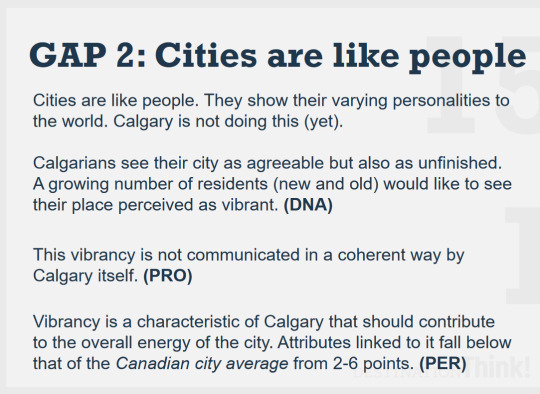
Hi, City of Edmonton, hire me to take an OCEAN test for our fair city. I'm begging you.
#aph oc#hetalia oc#hws oc#projectcanada cities#battle of alberta#aph edmonton#aph calgary#pc: edmonton#pc: calgary#edward murphy#calvin mccall#traditional art#boab meta#OC tober#OC_tober#ink#watercolour#mixed media#hapo art#ITS FINALLY DONE
22 notes
·
View notes